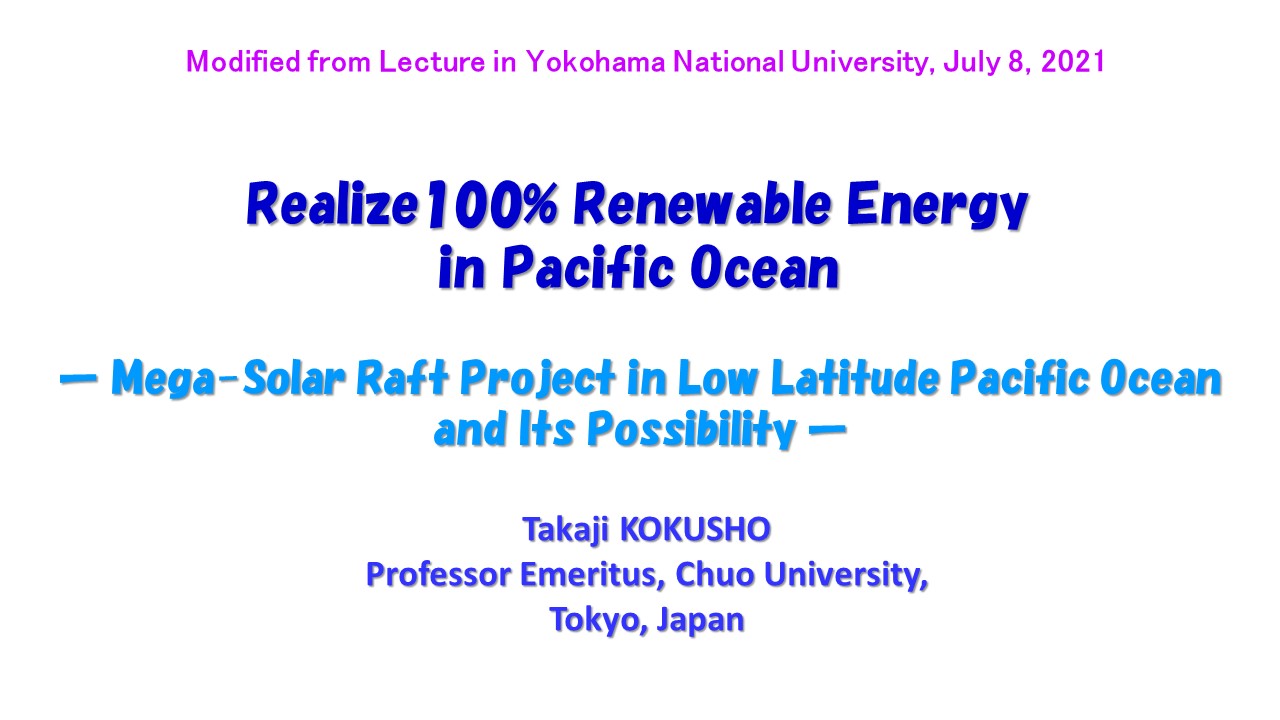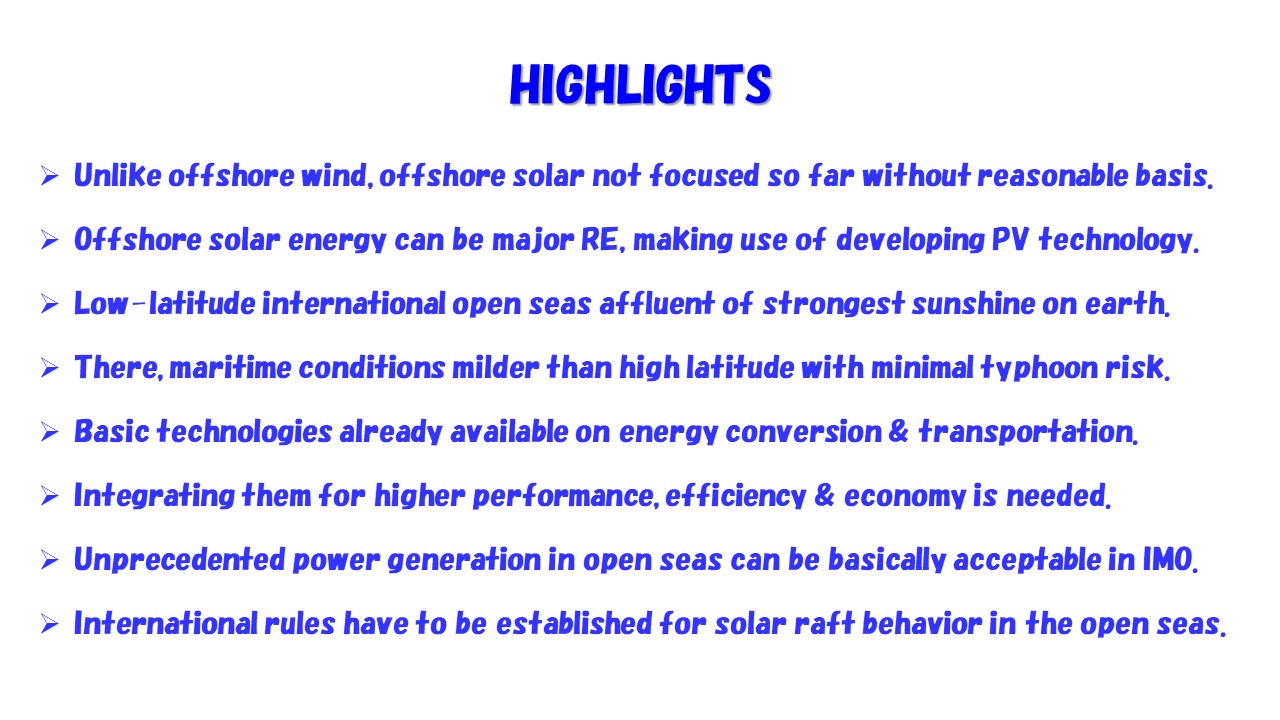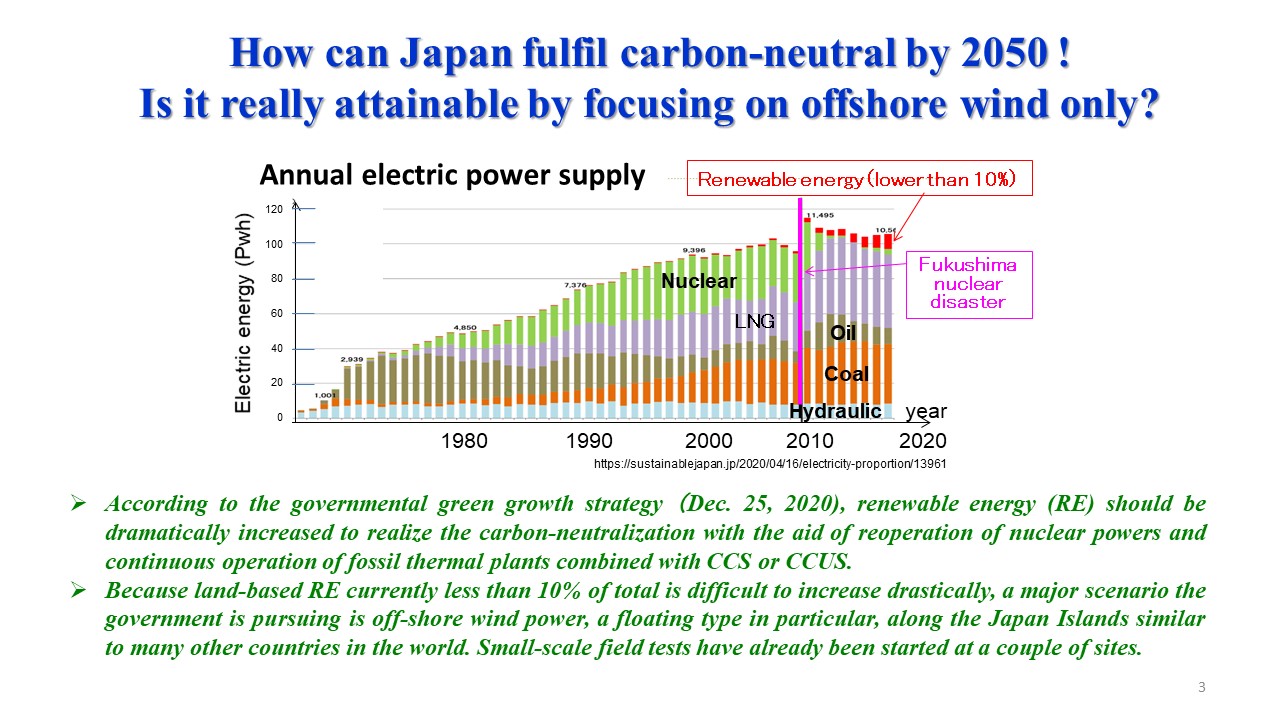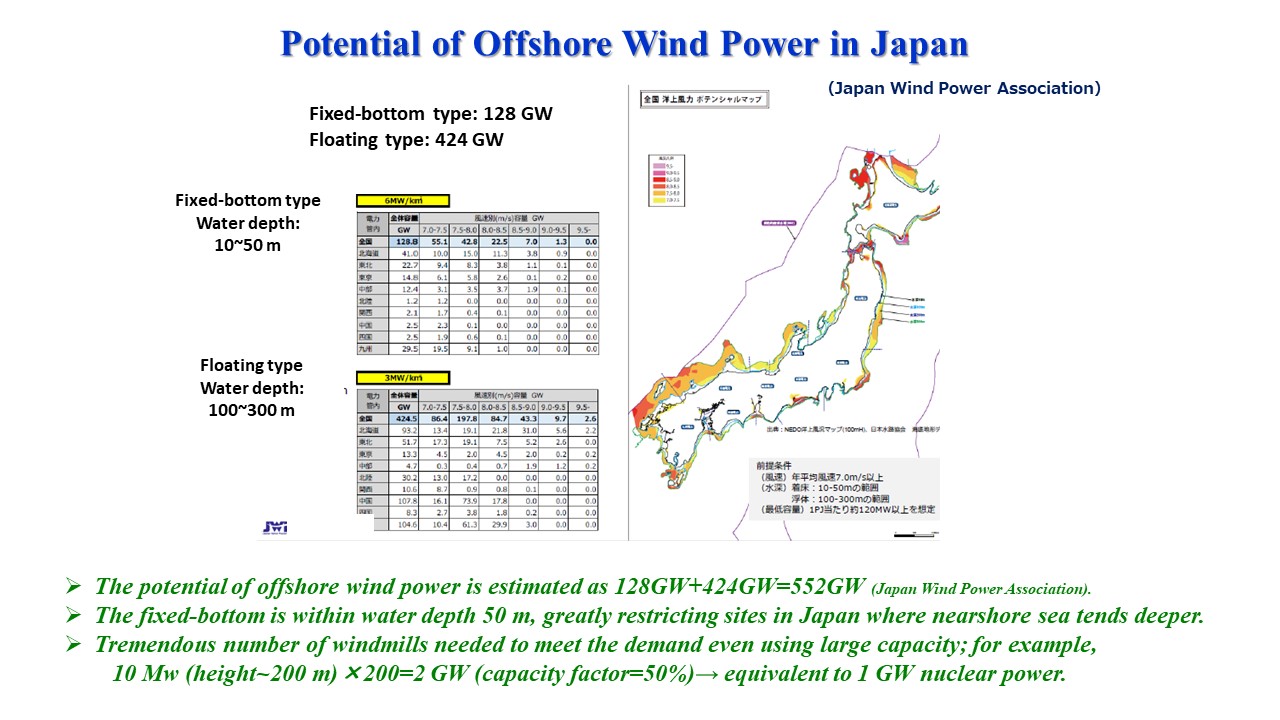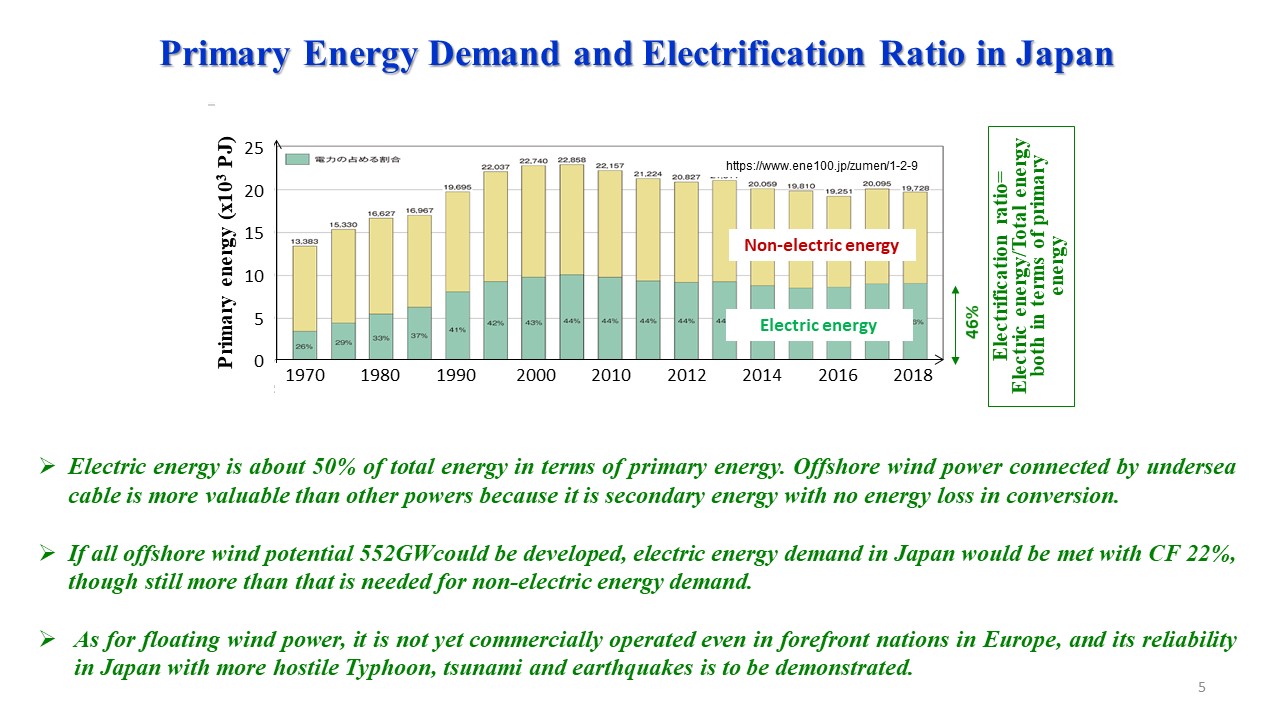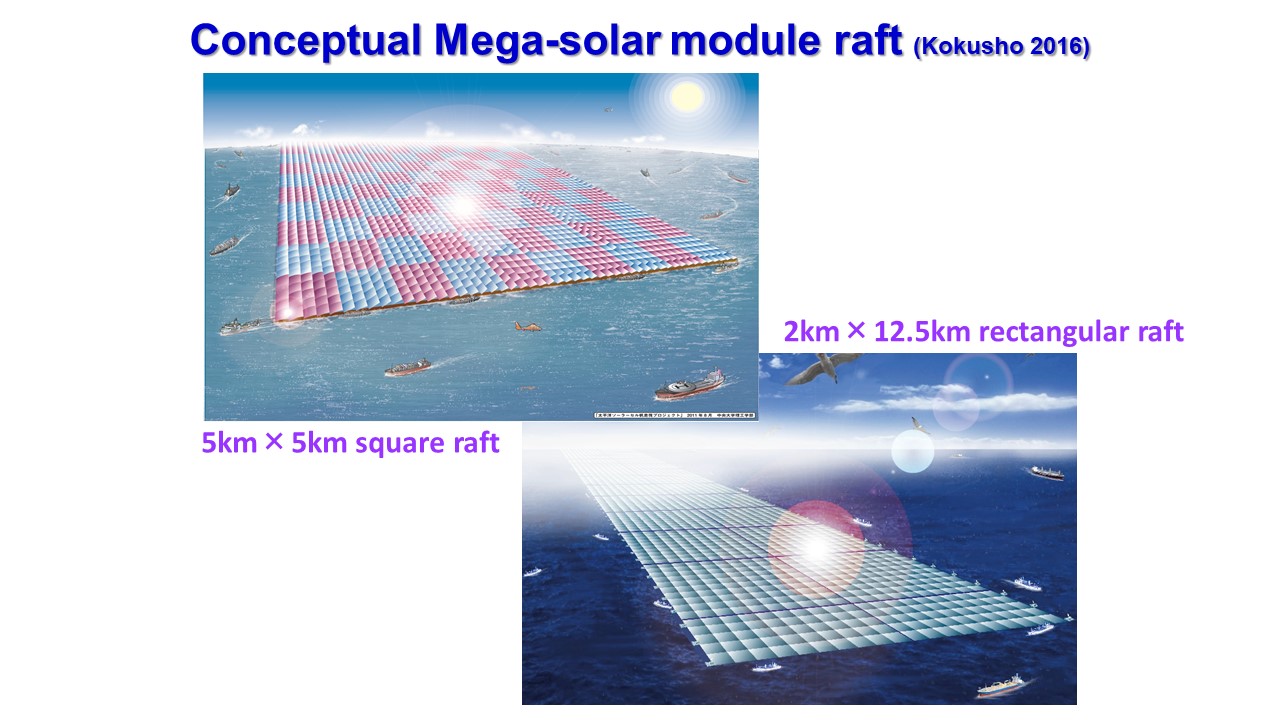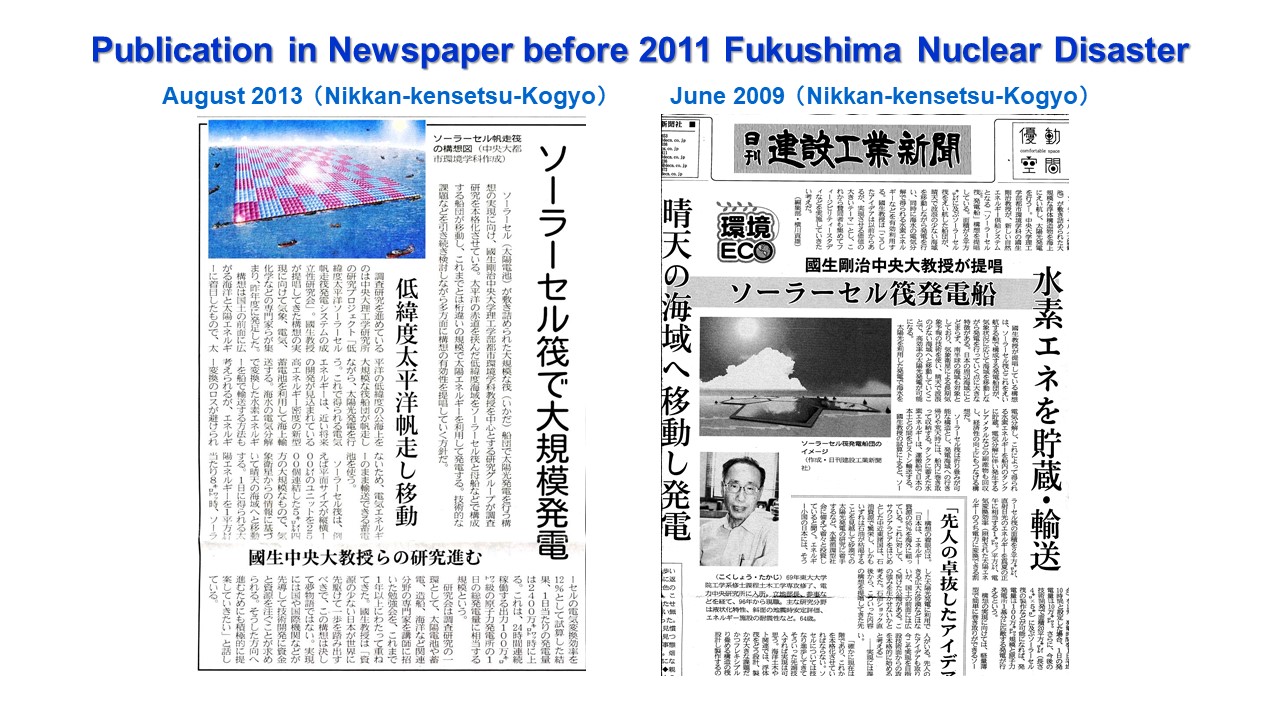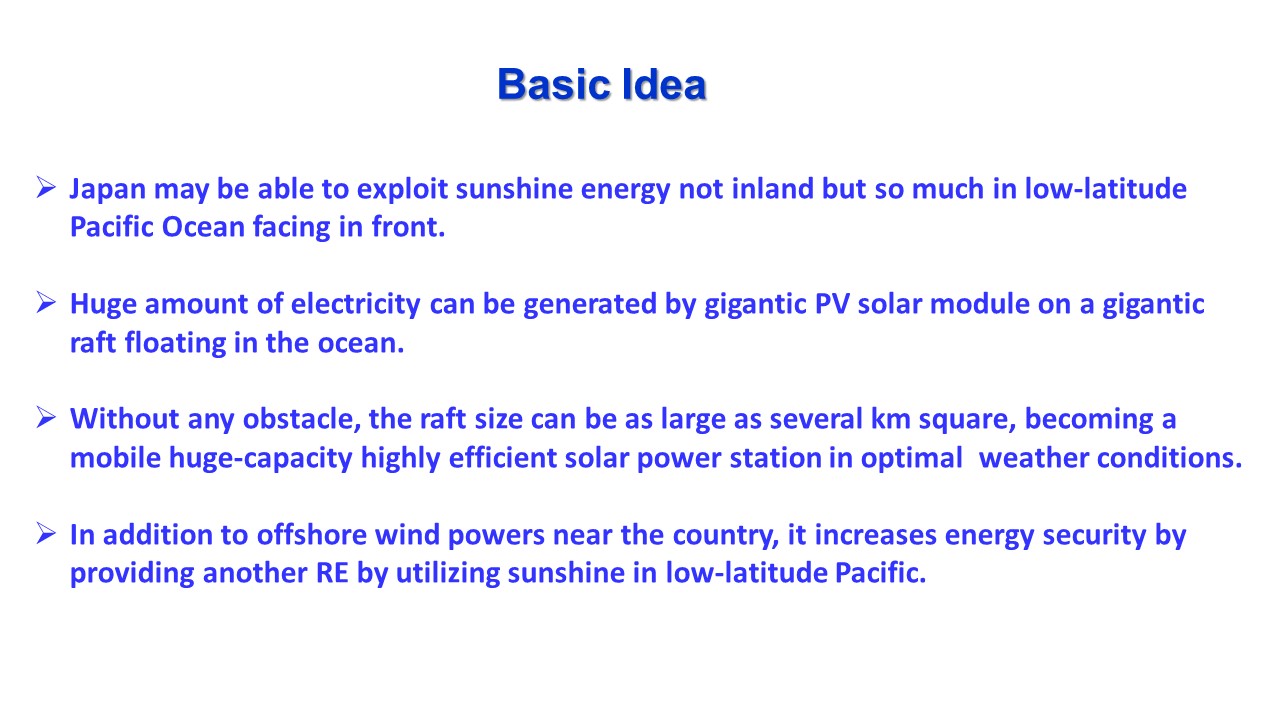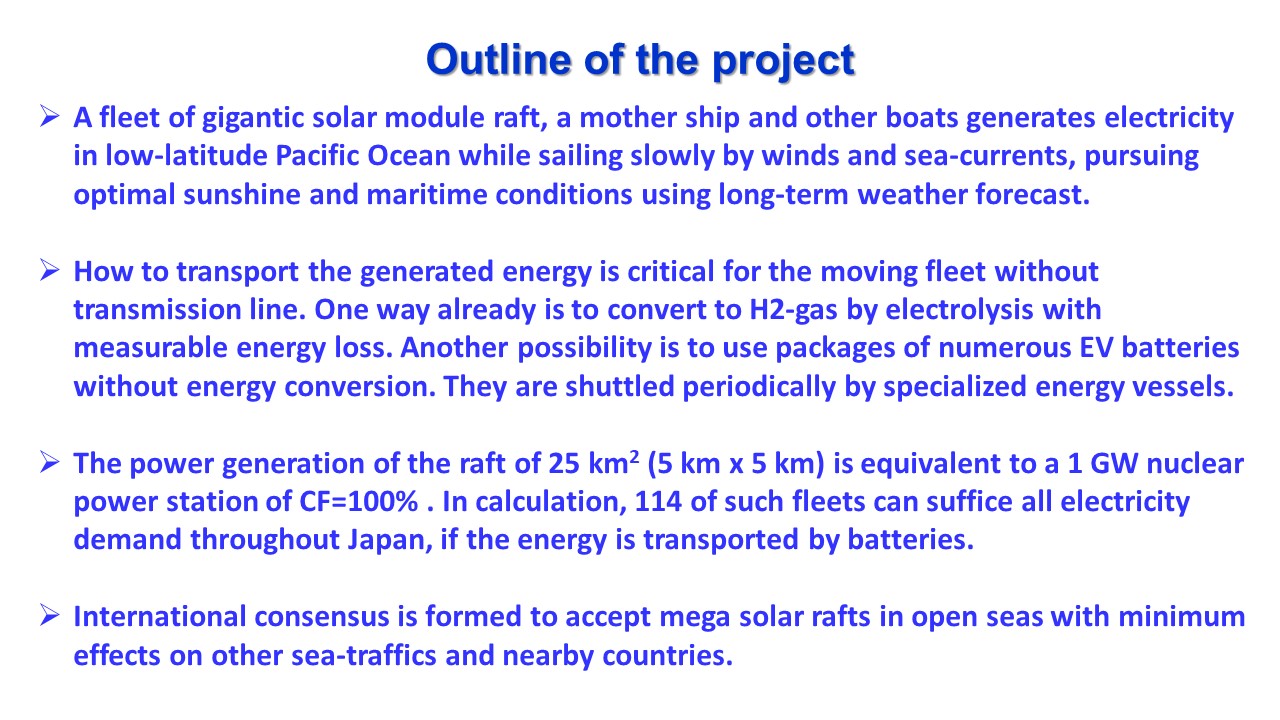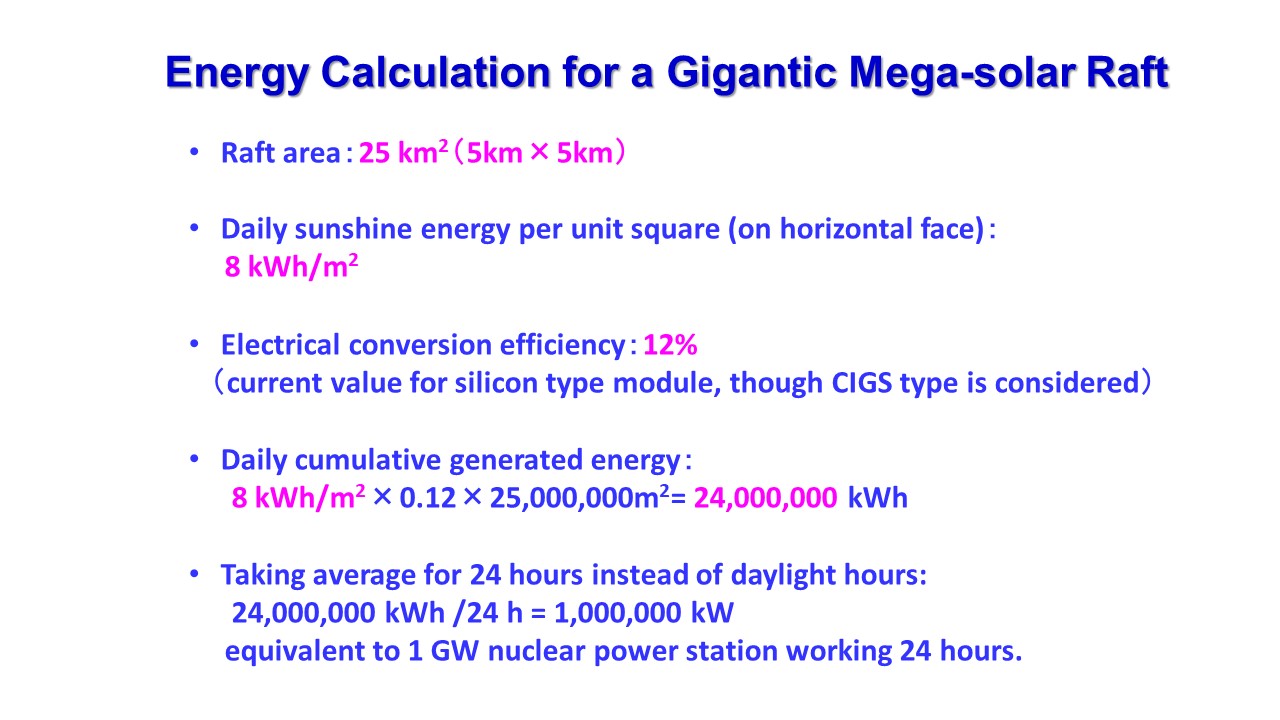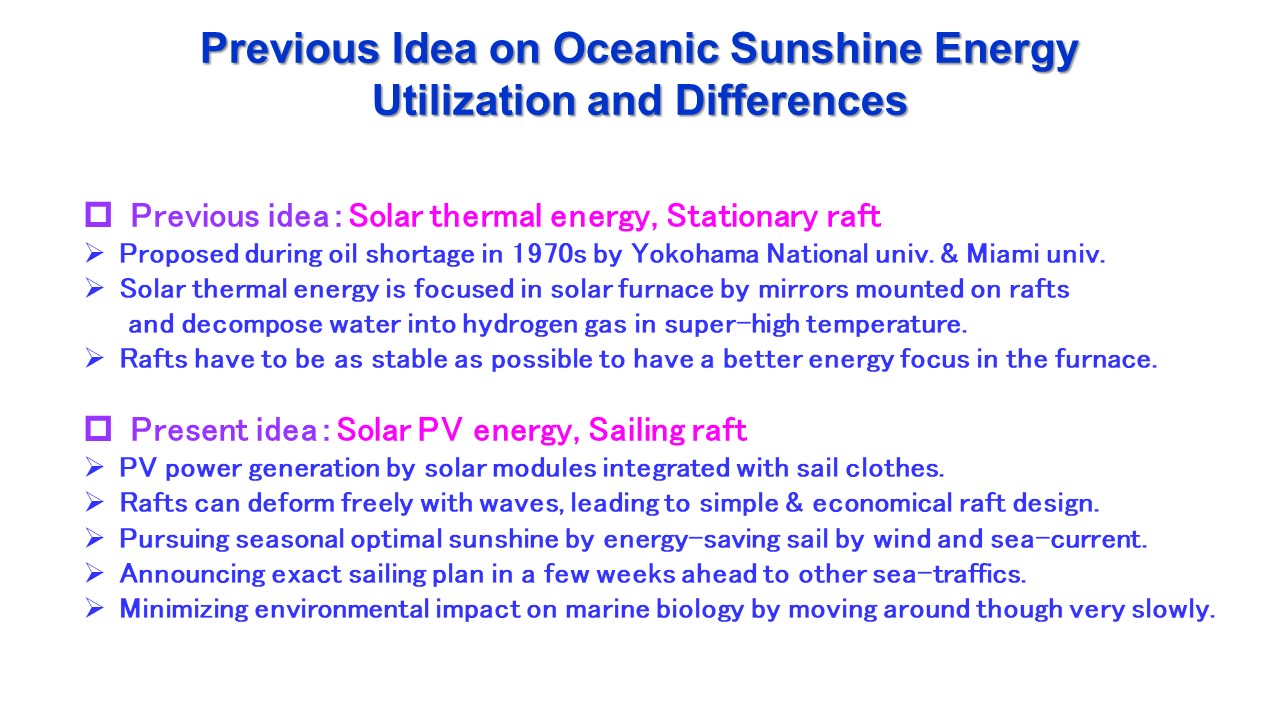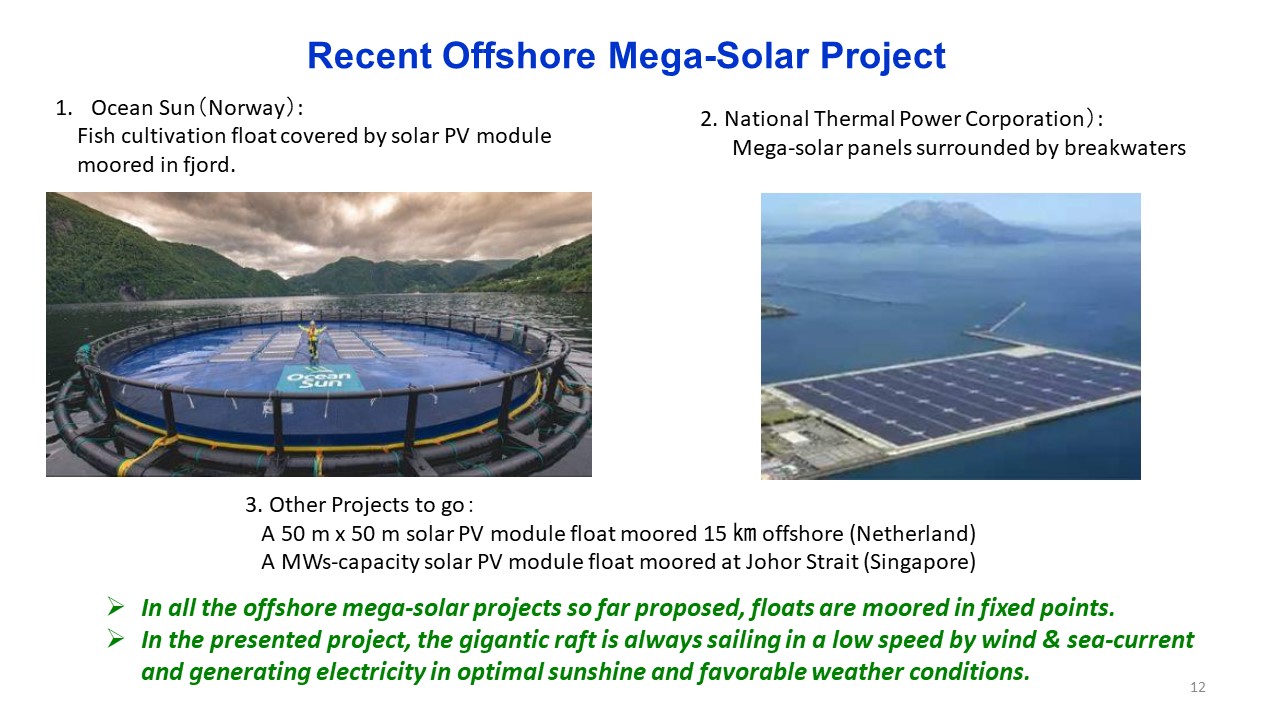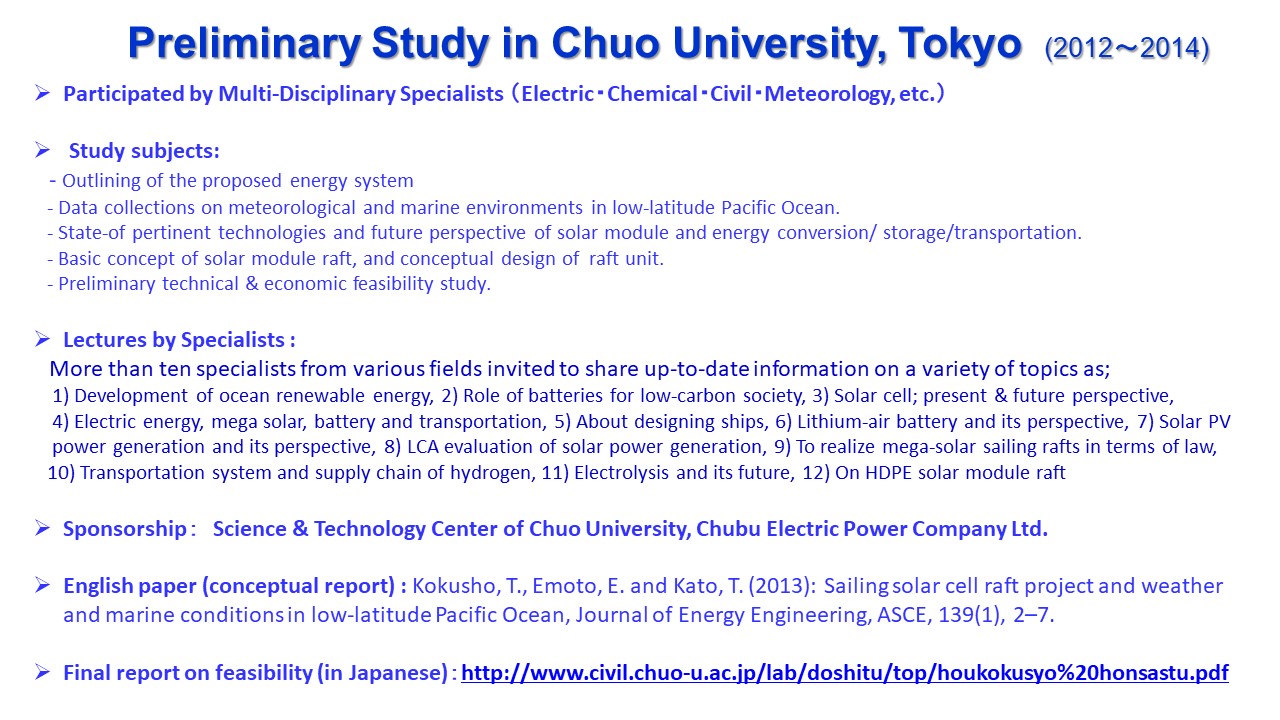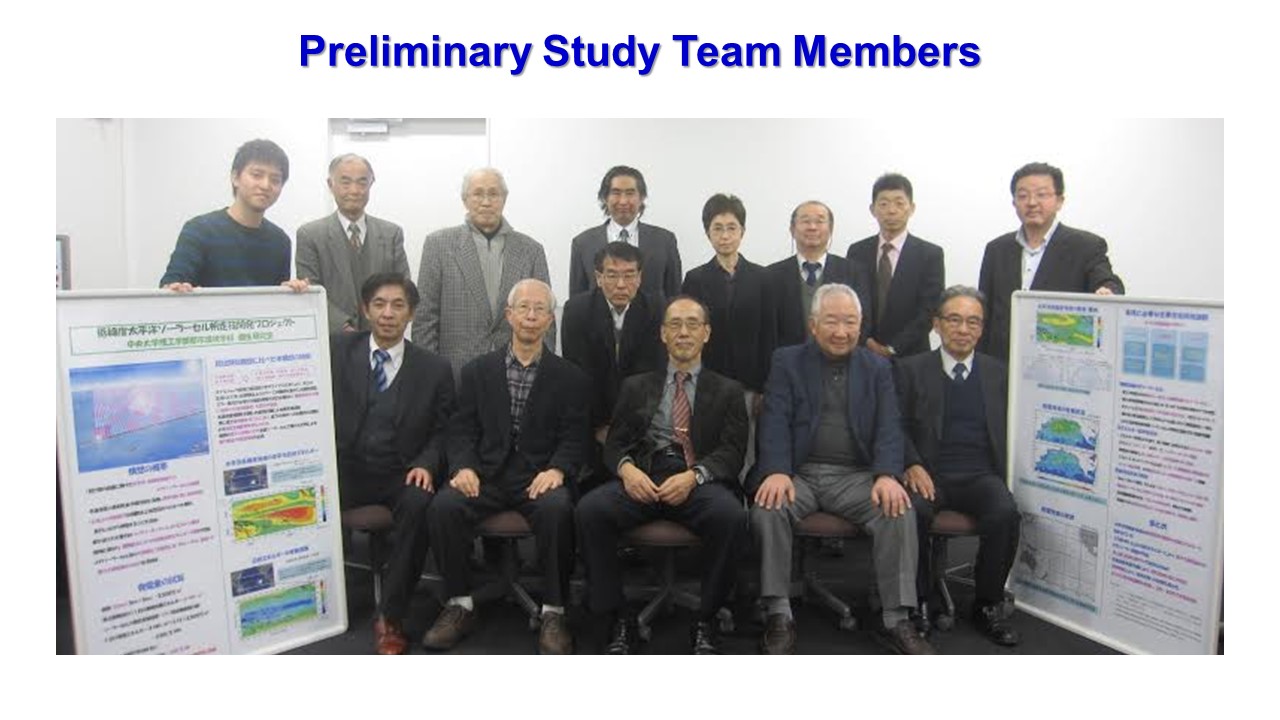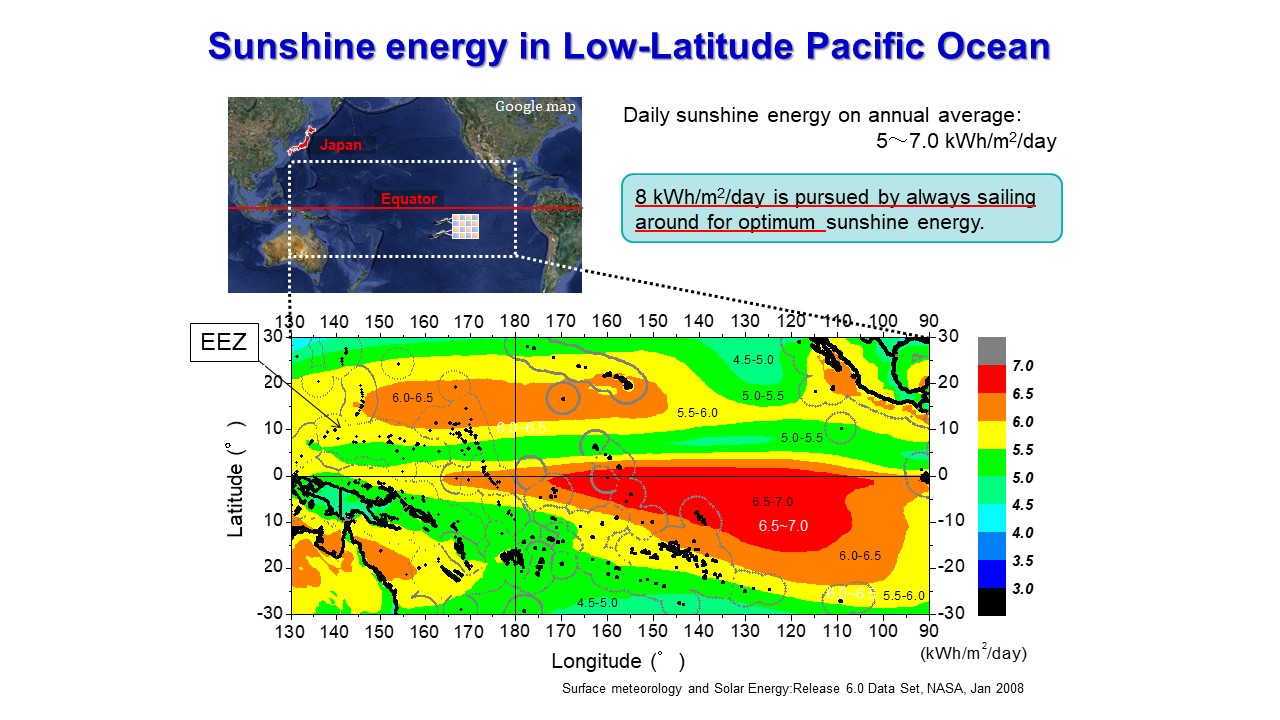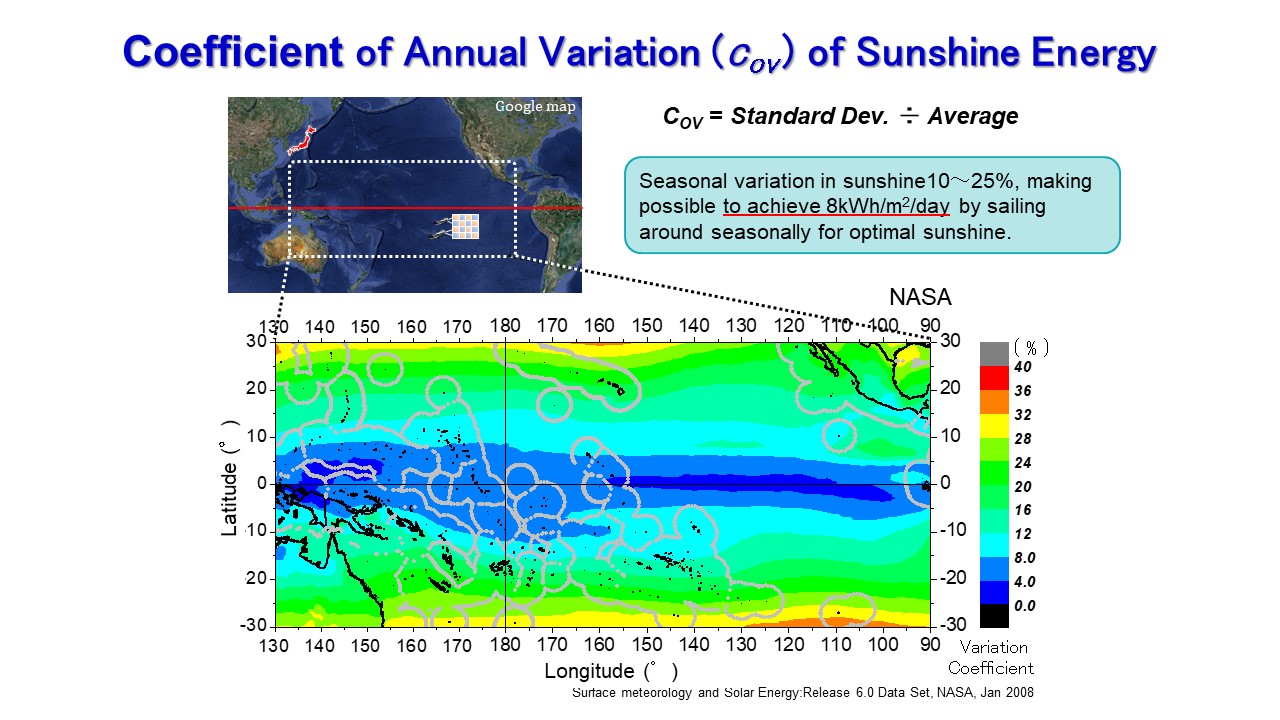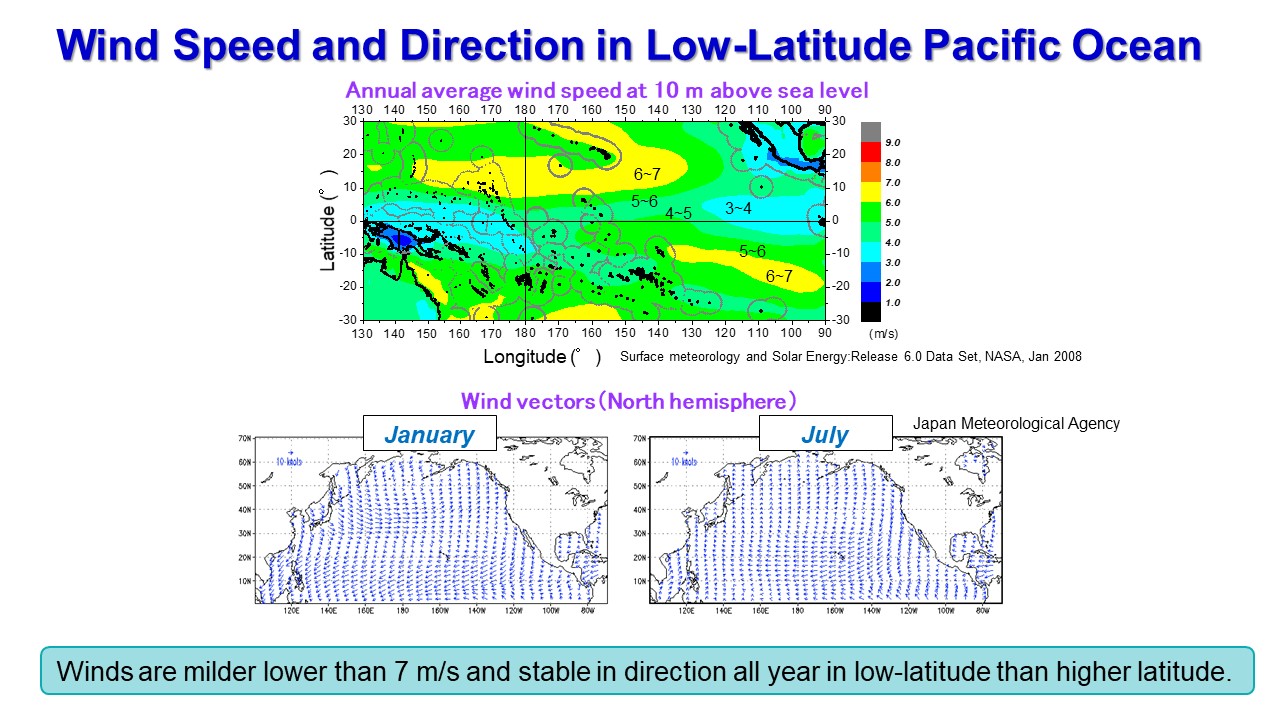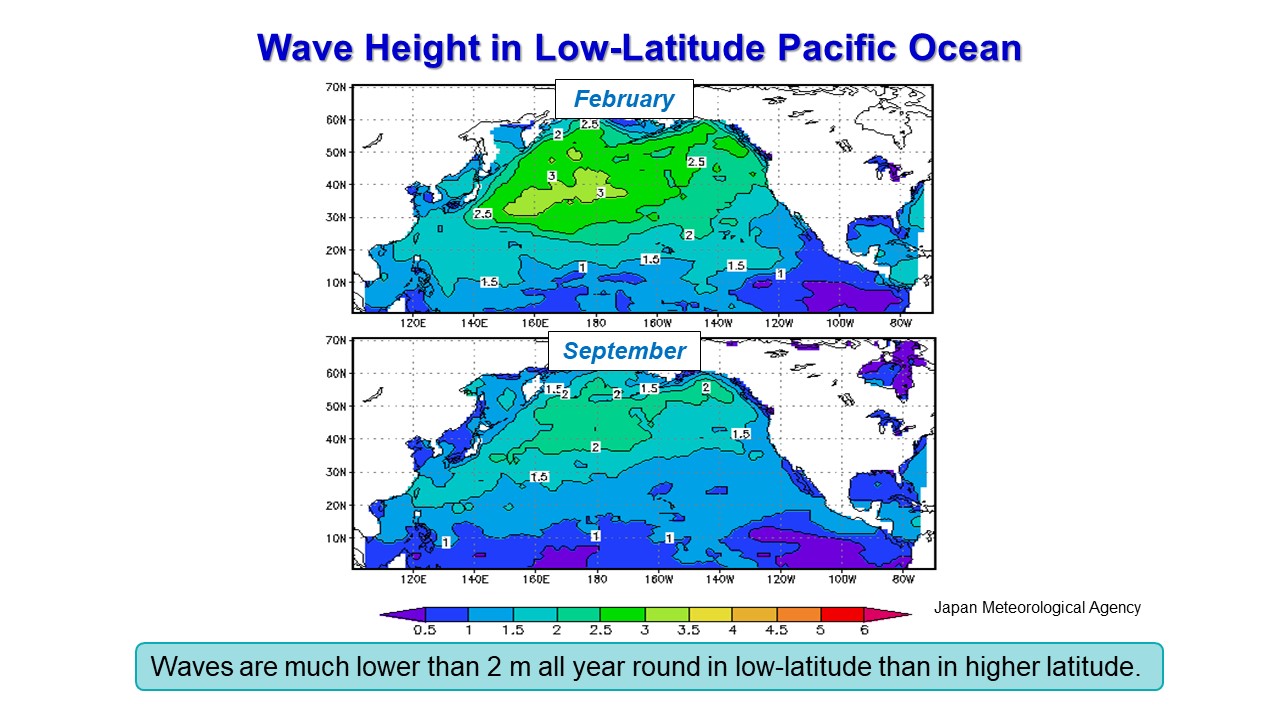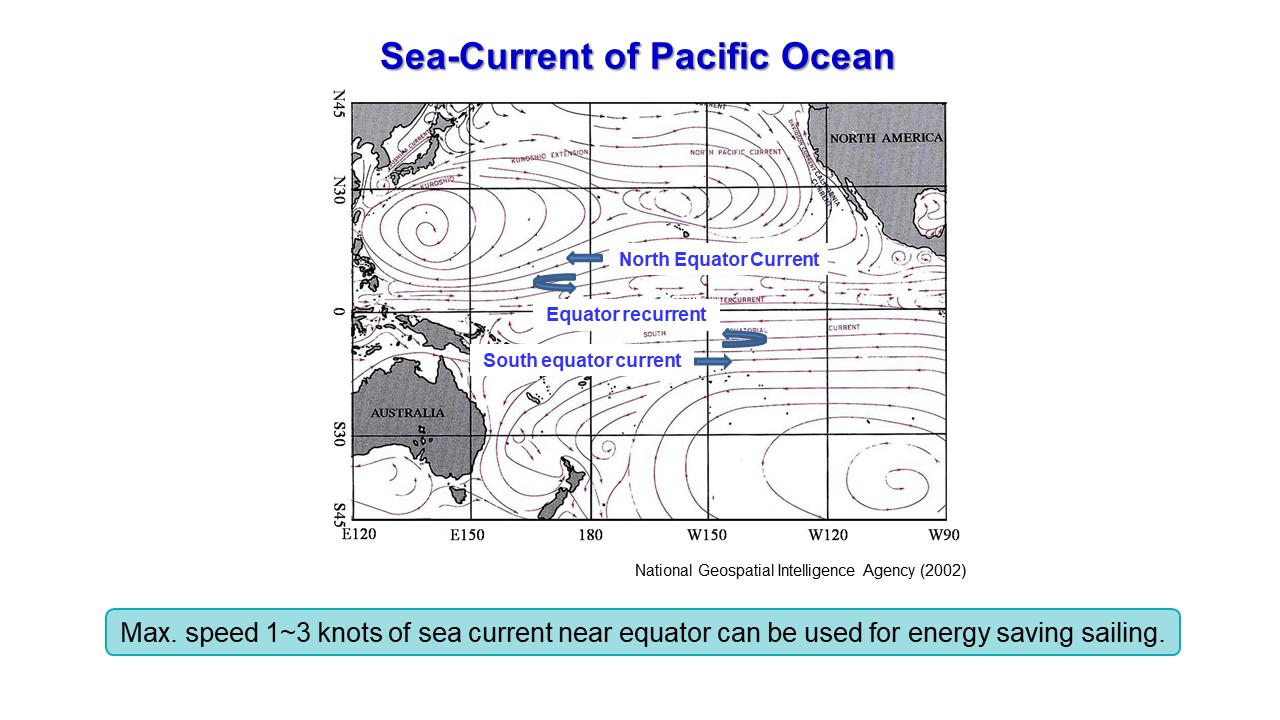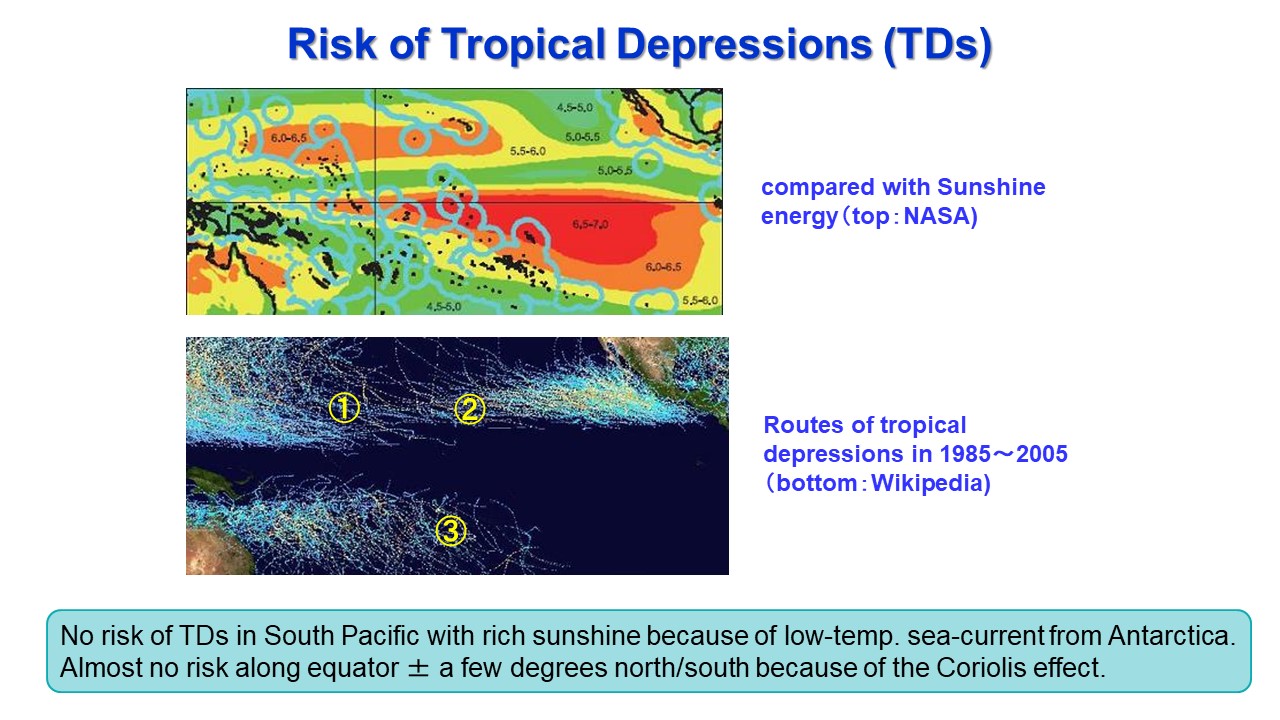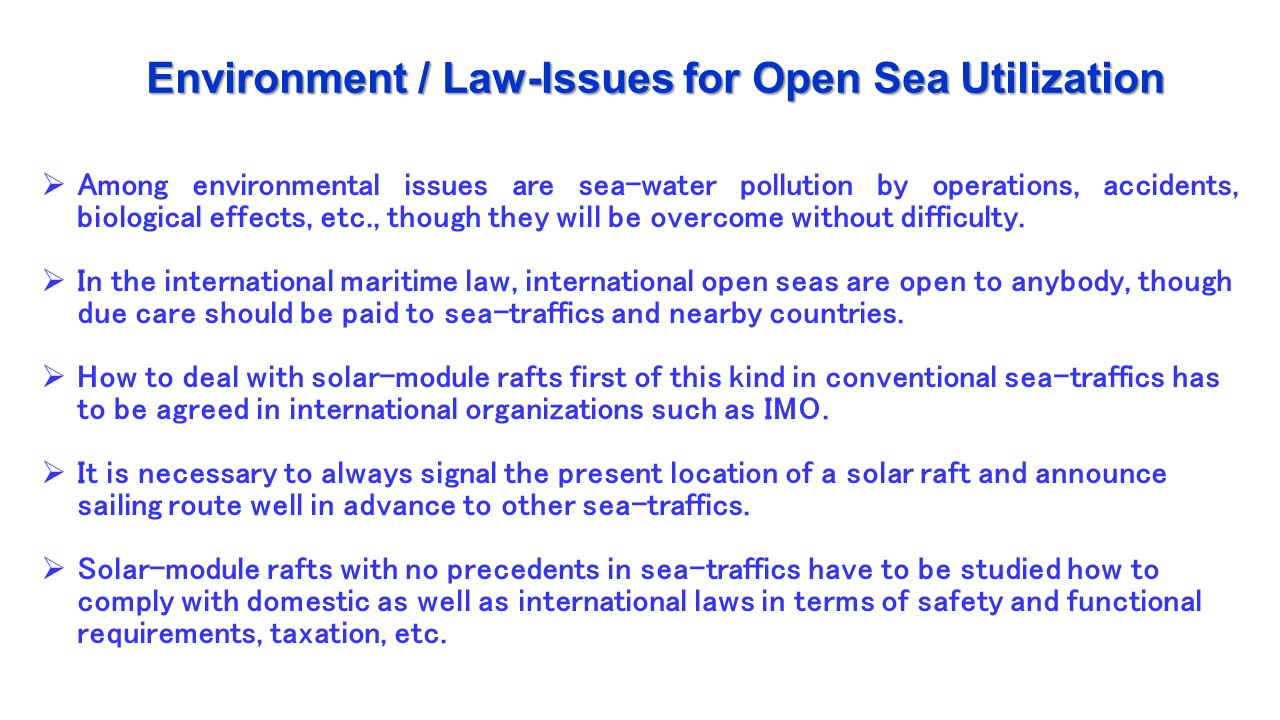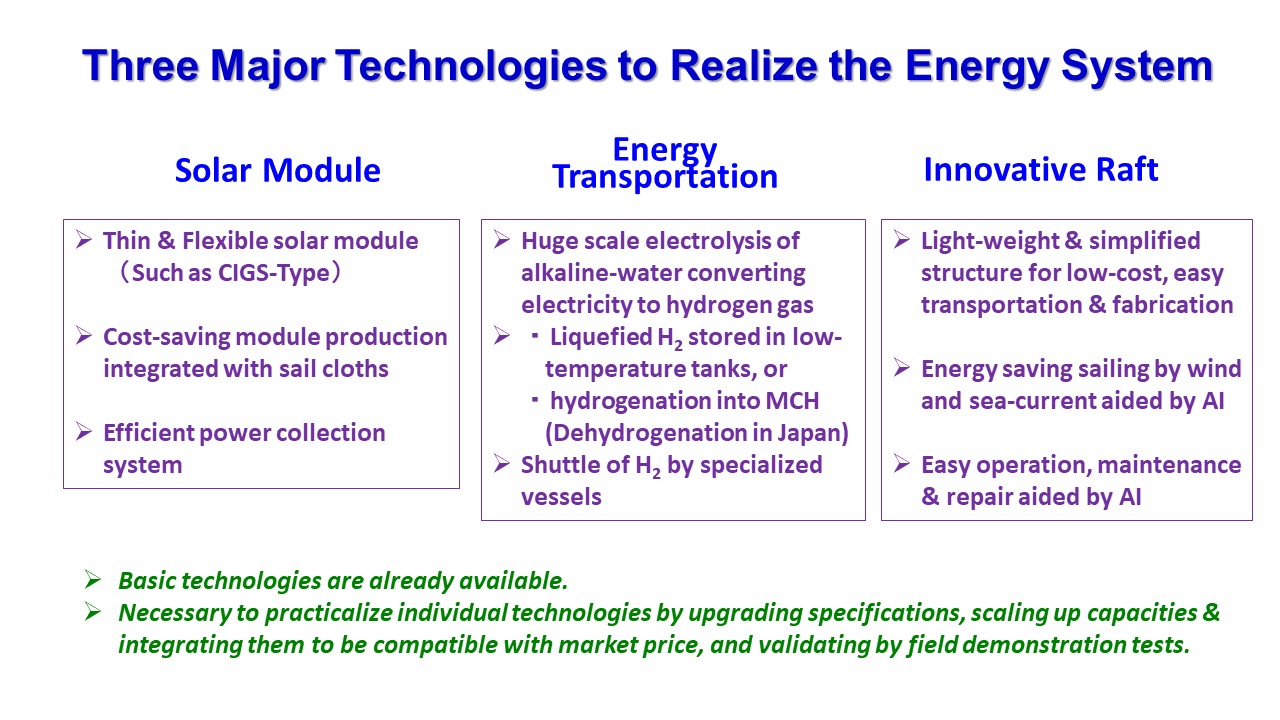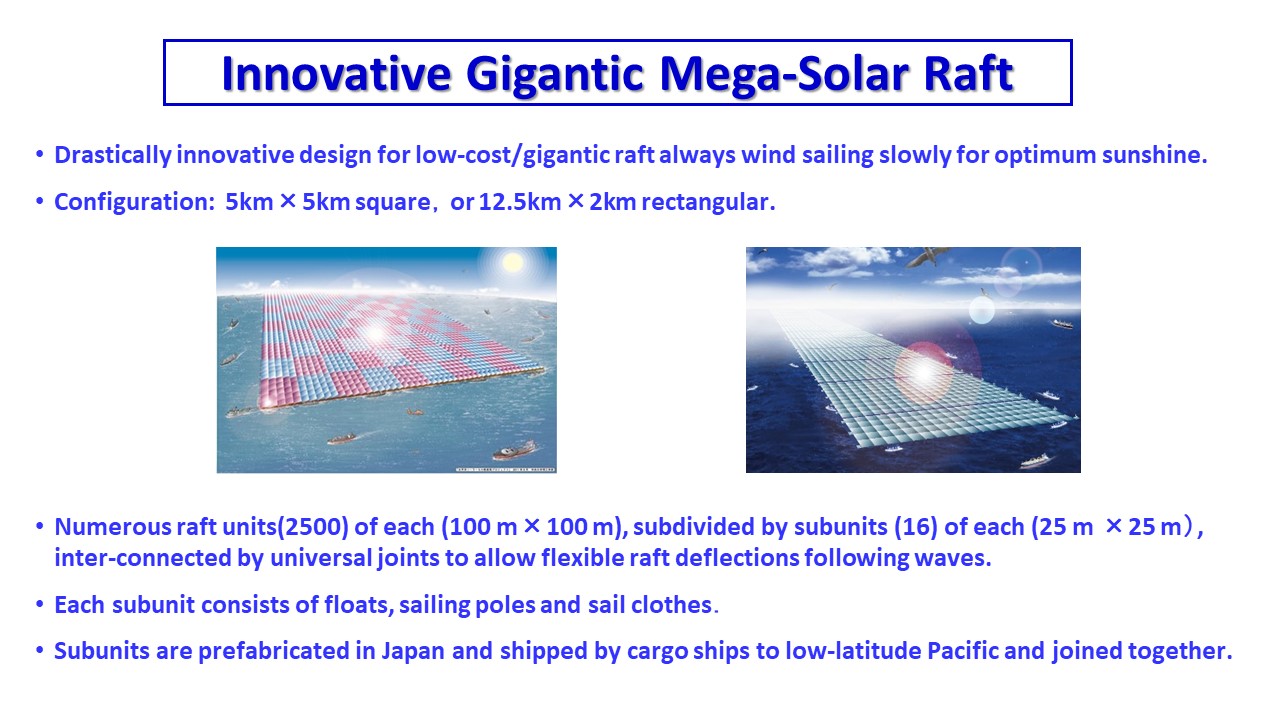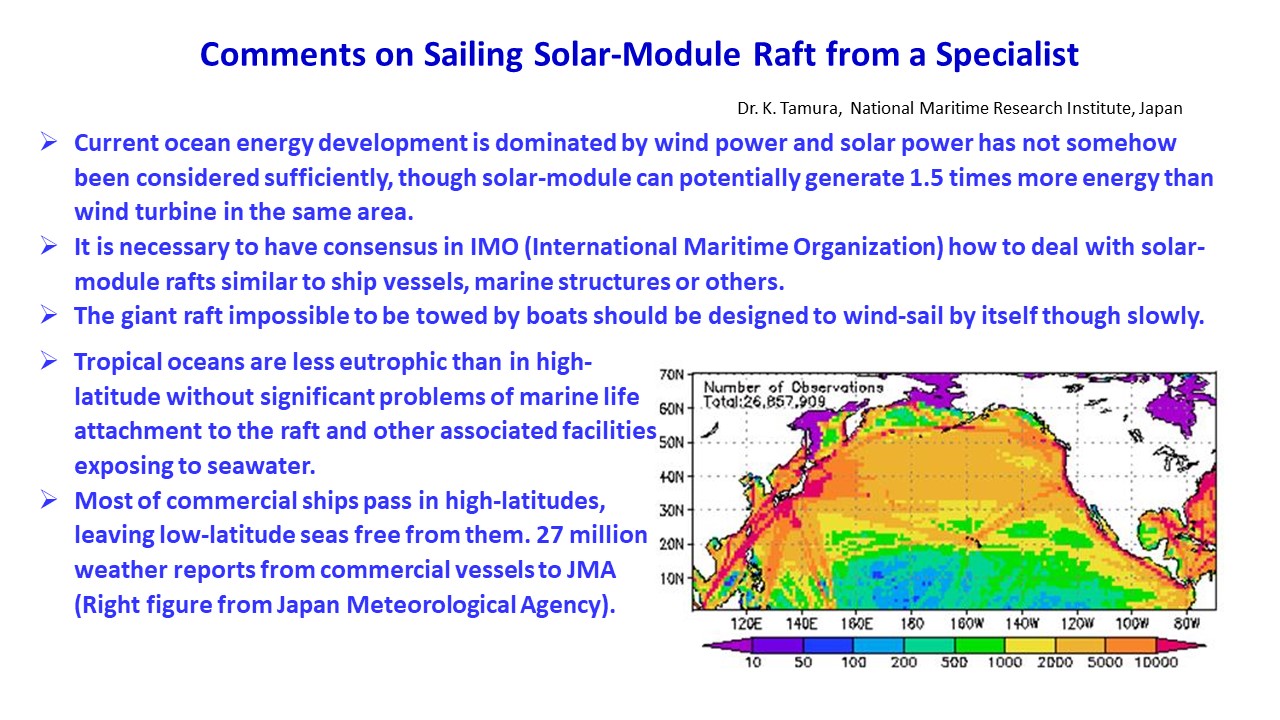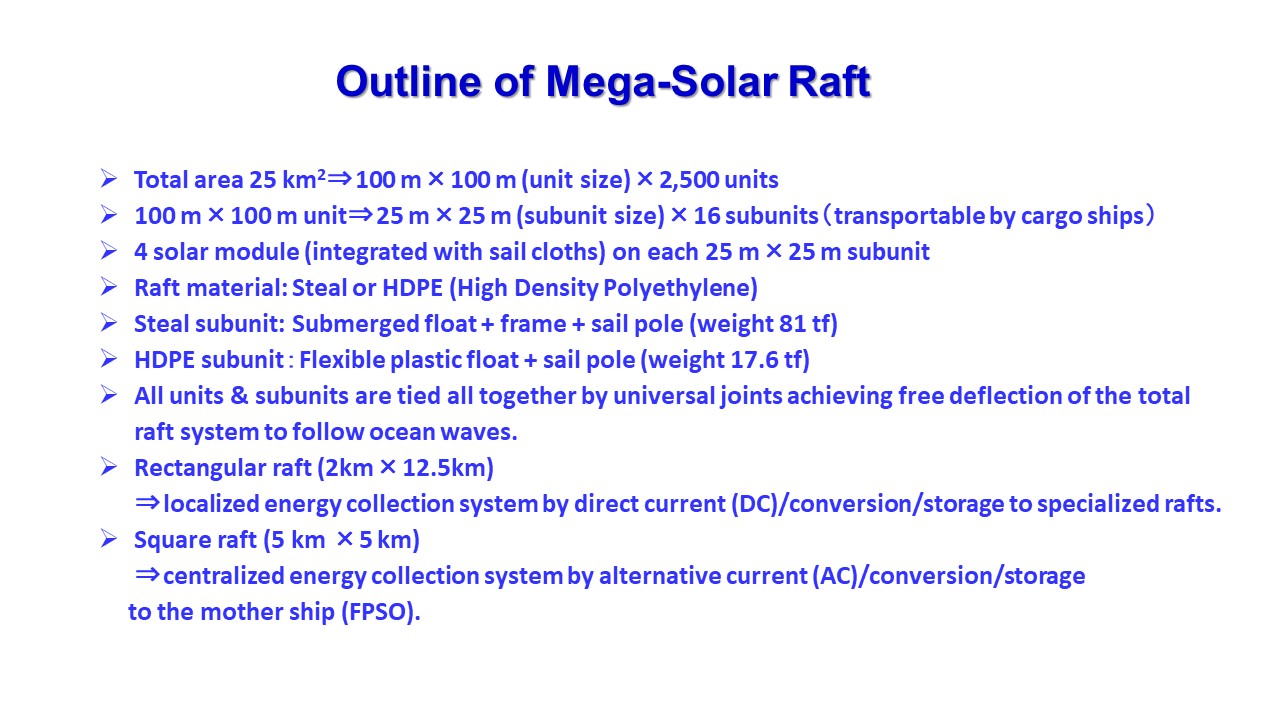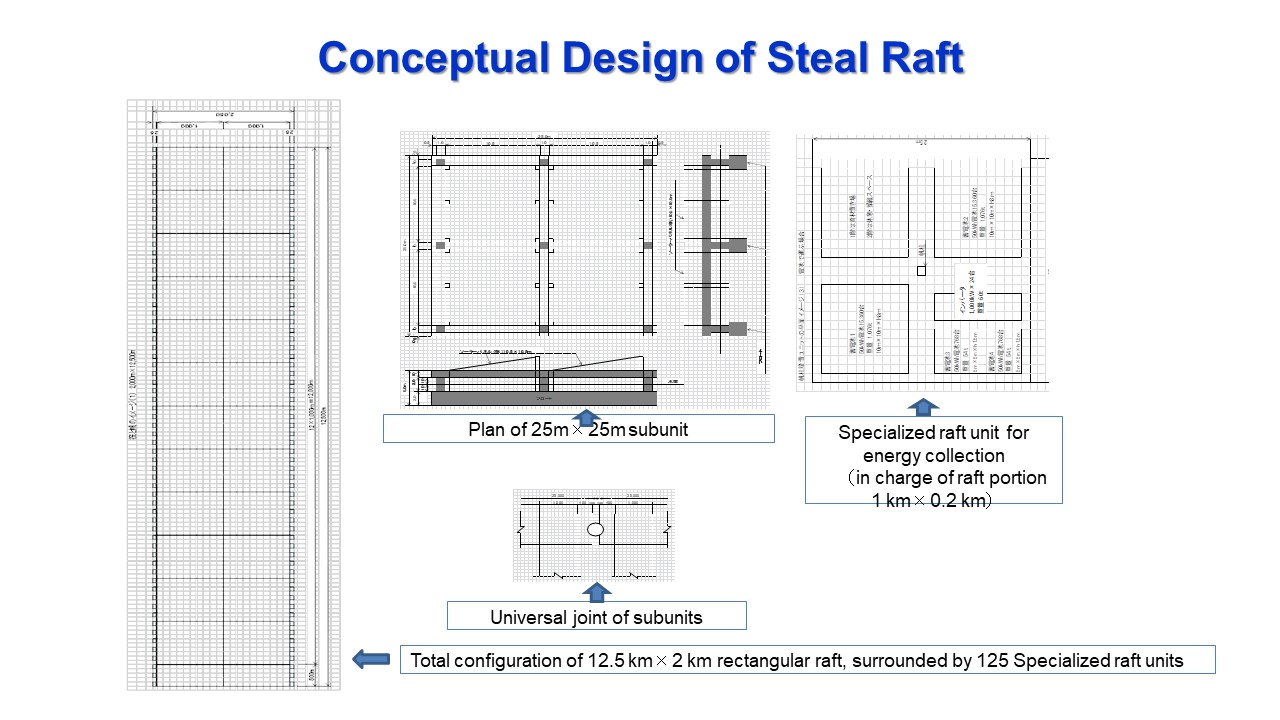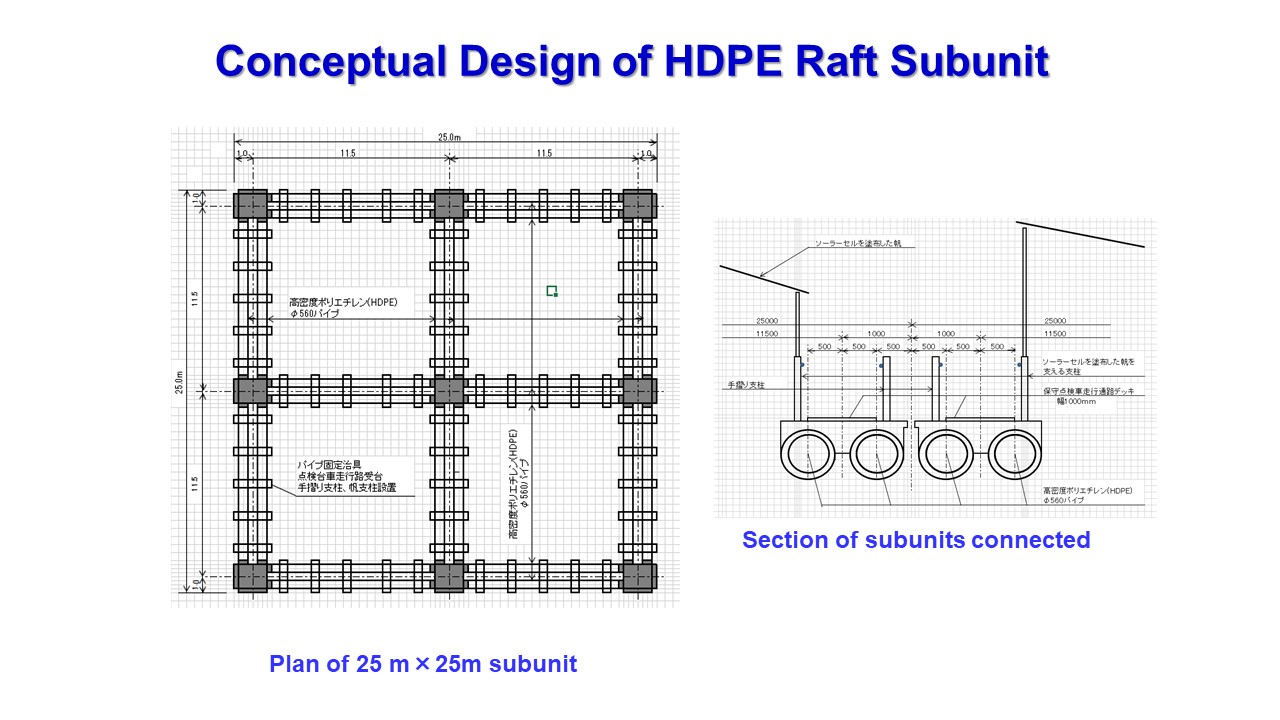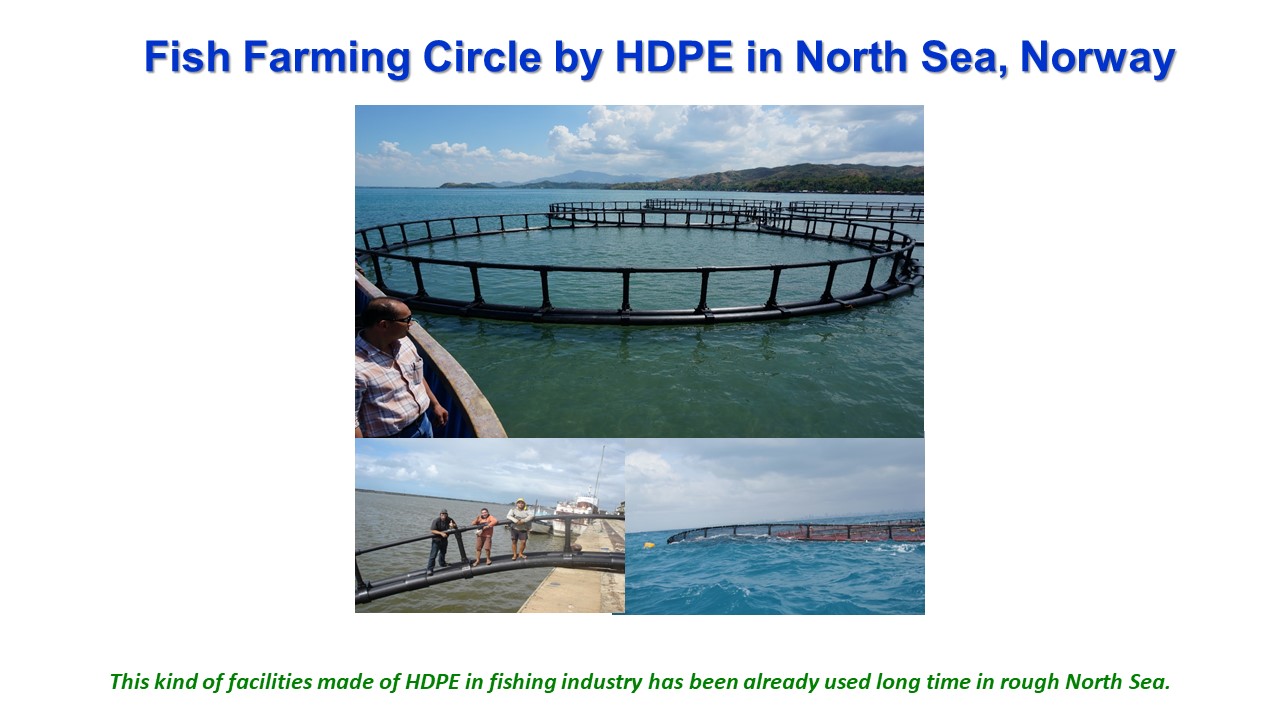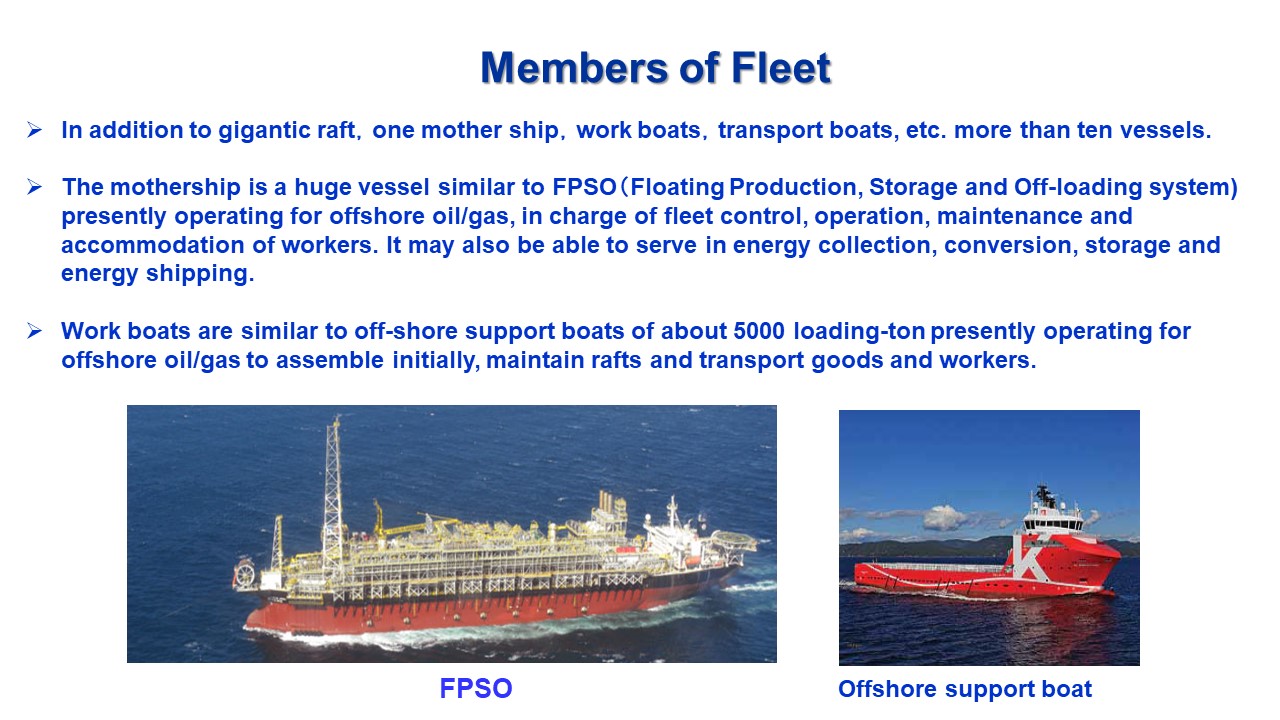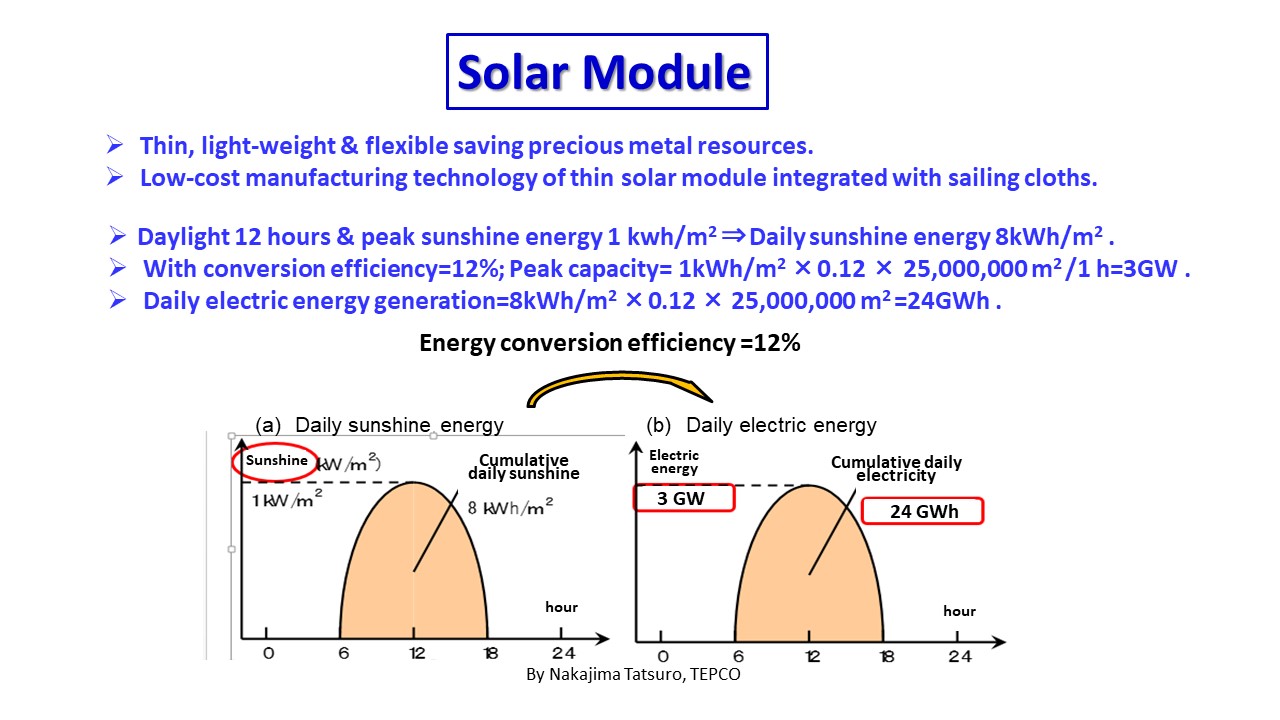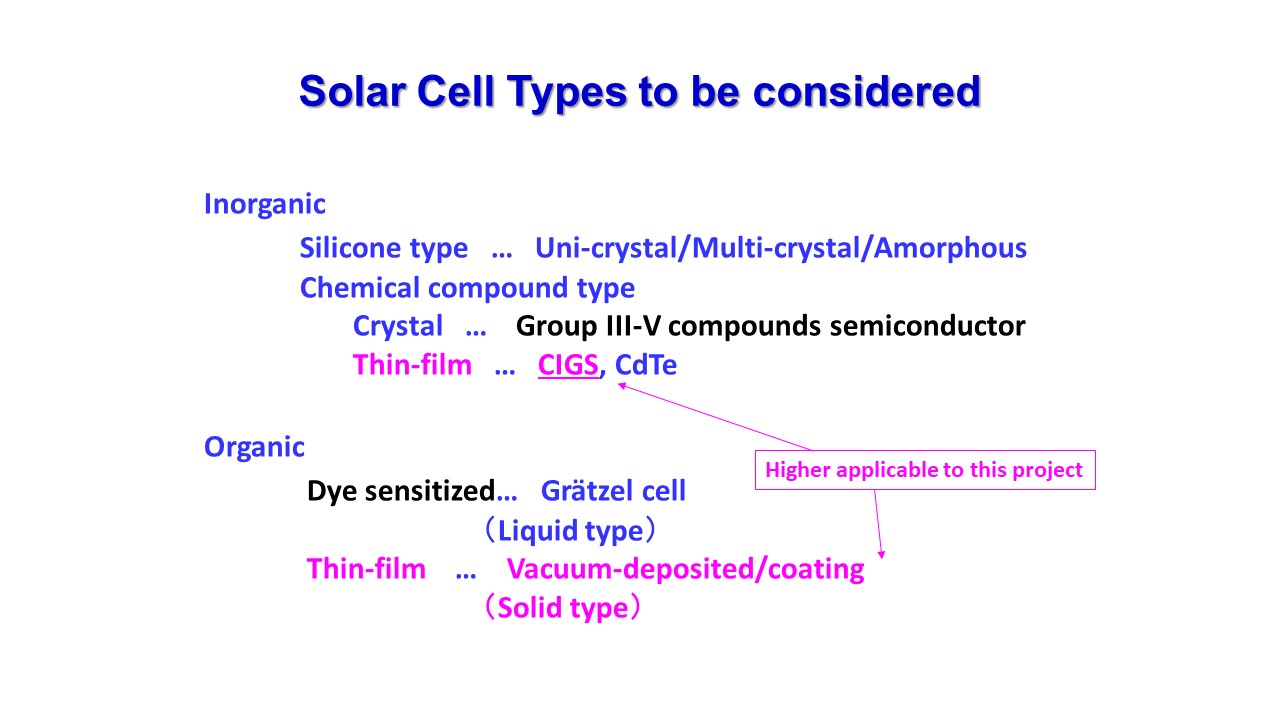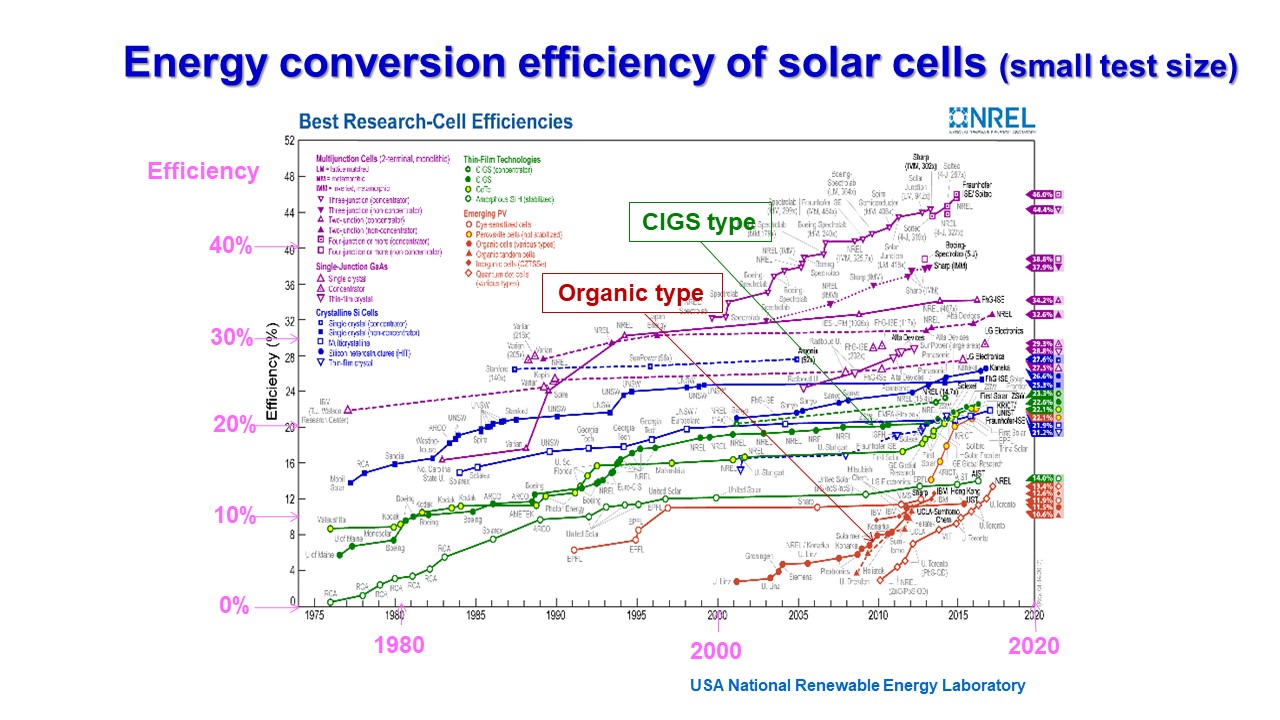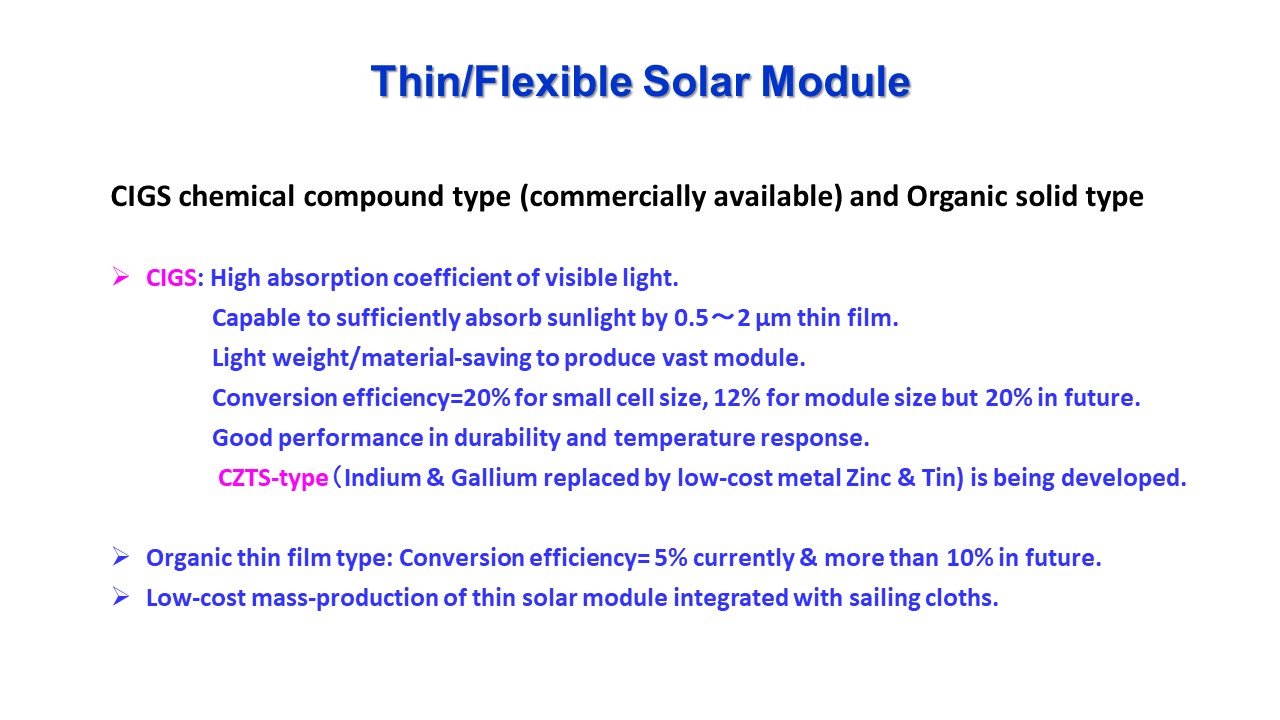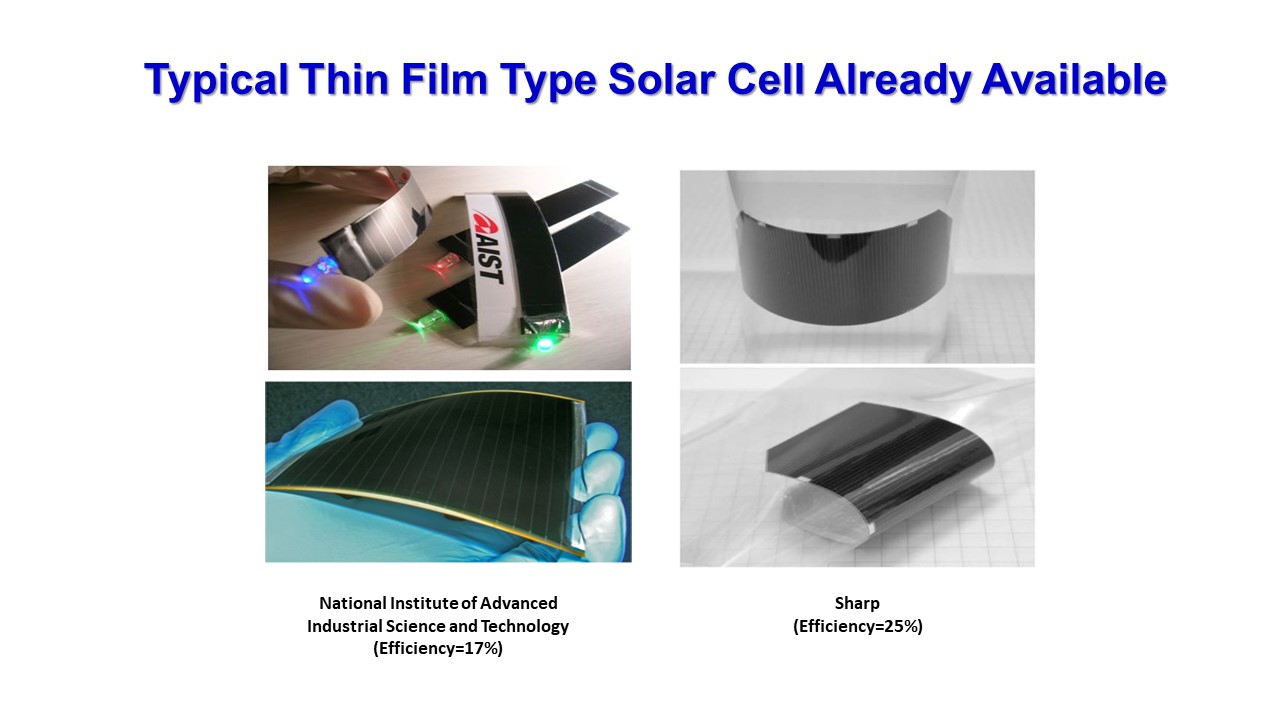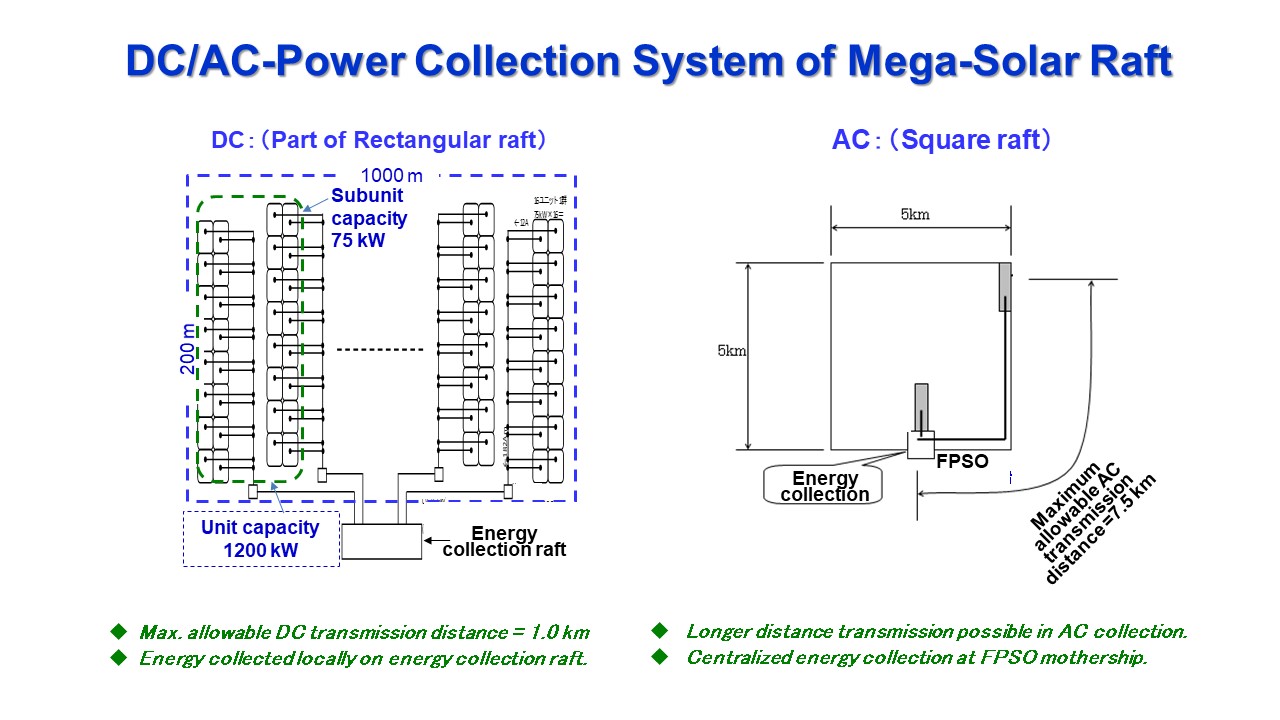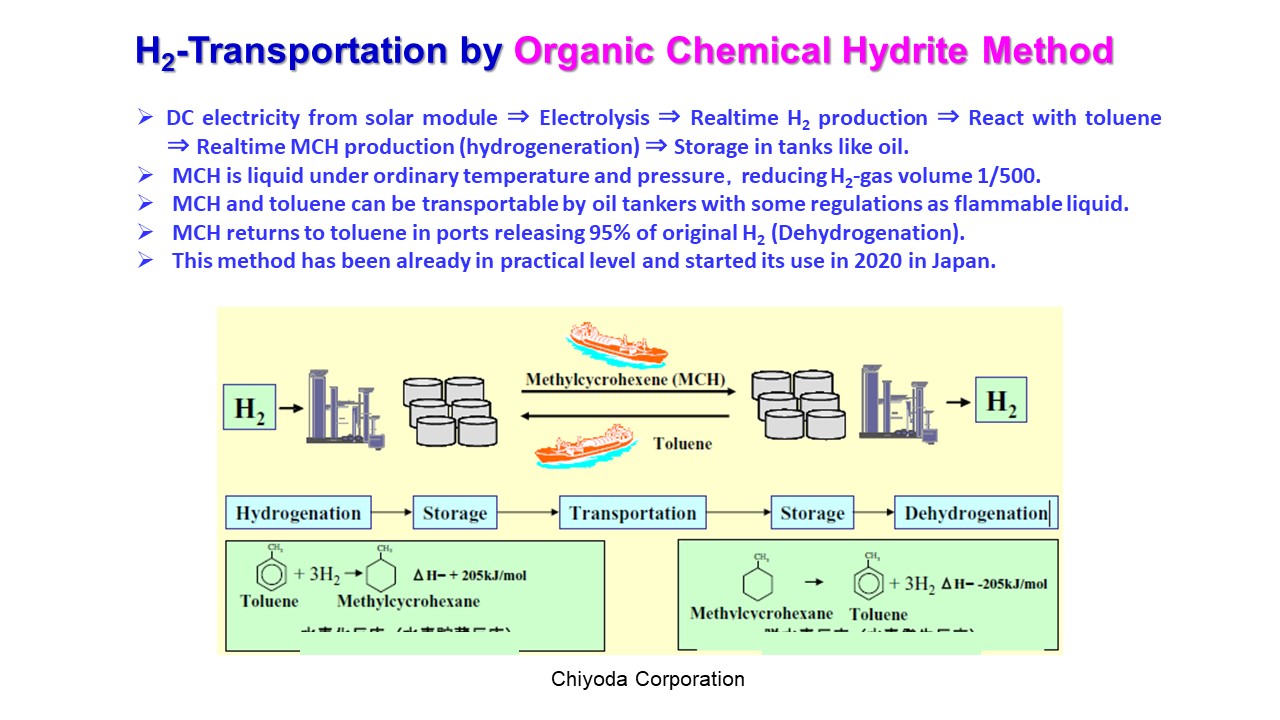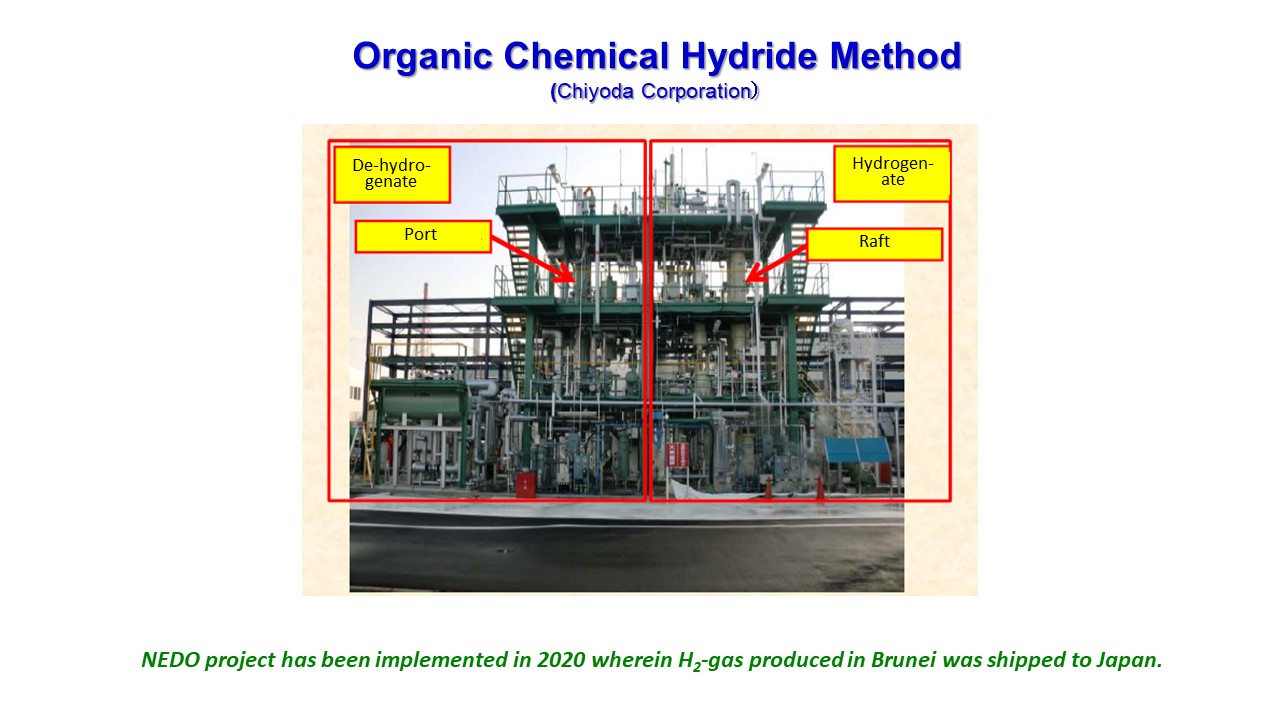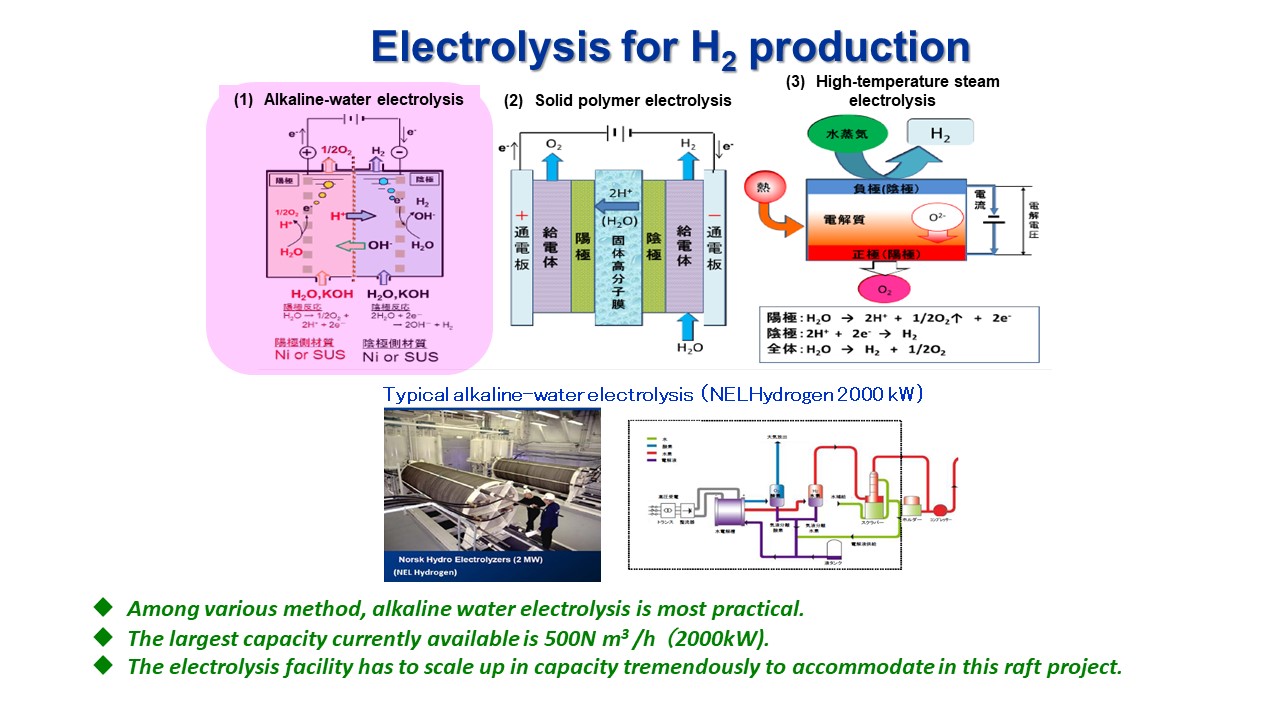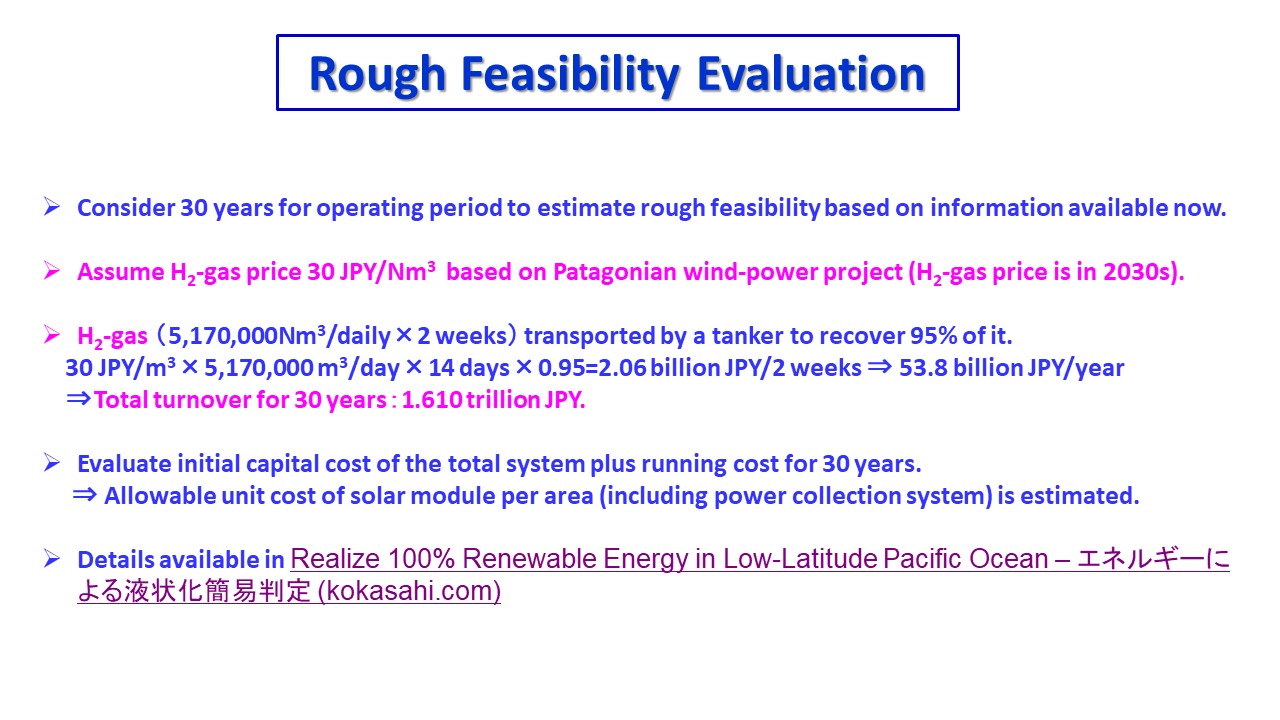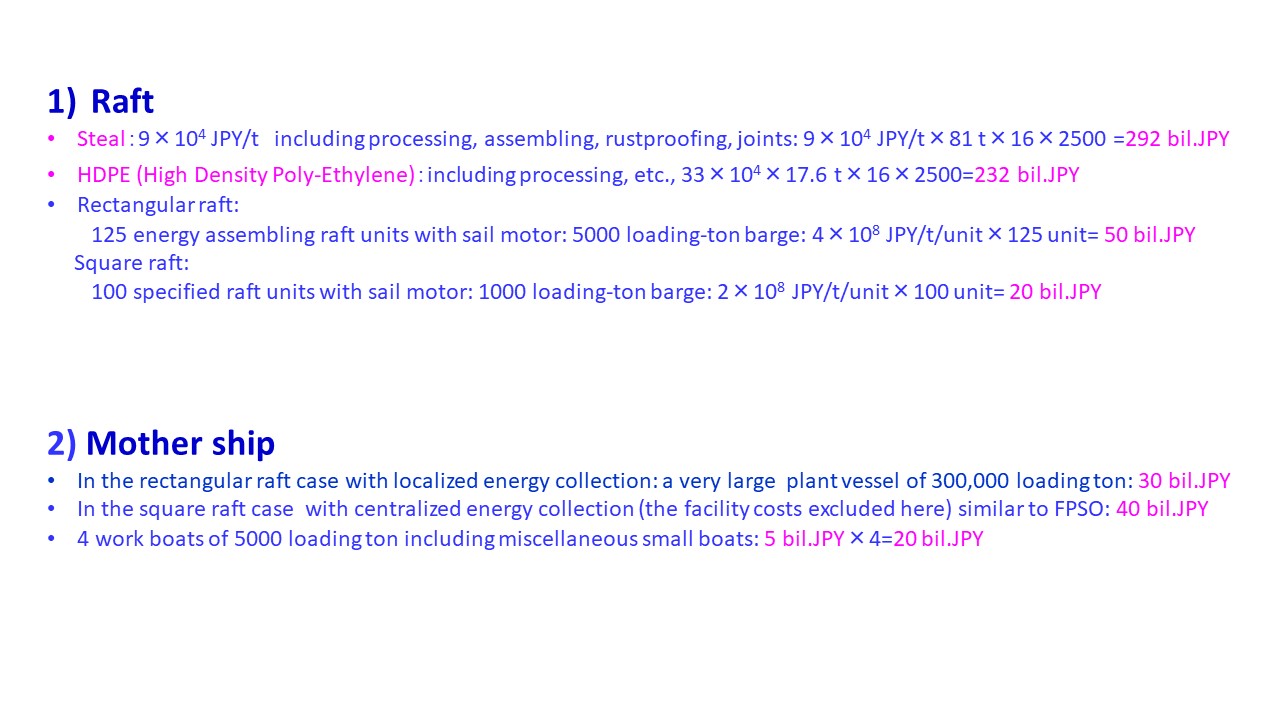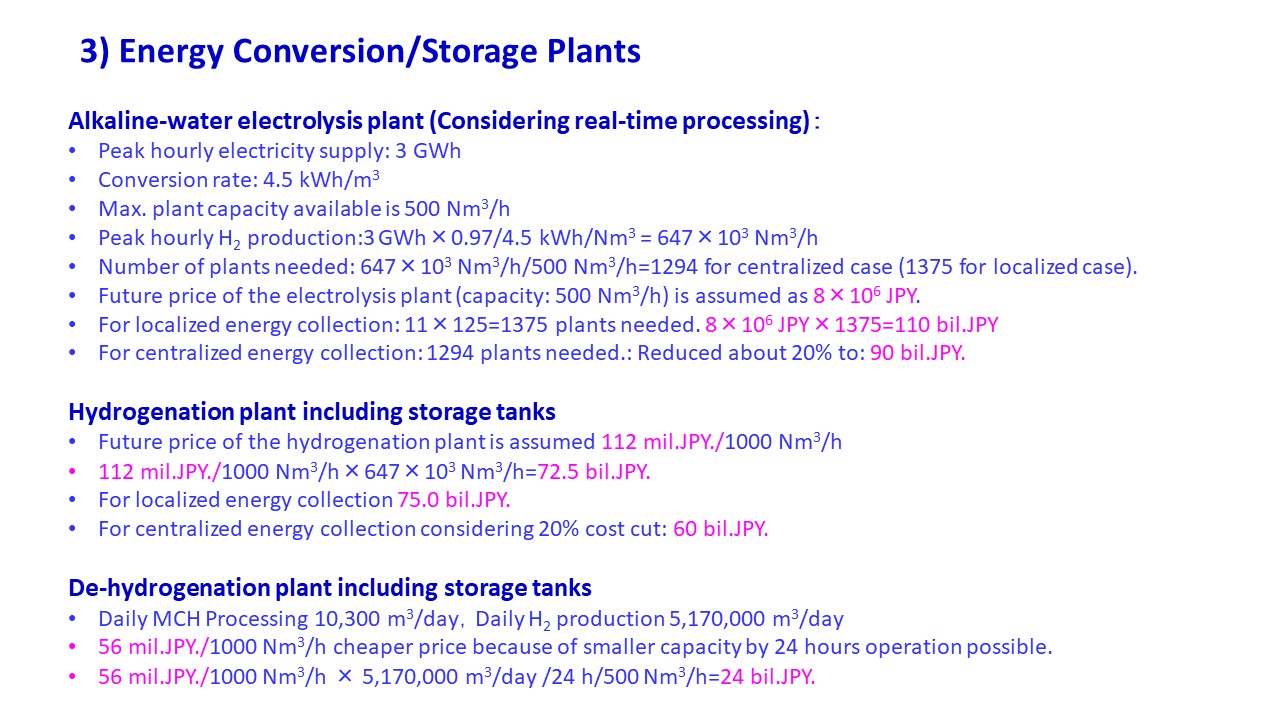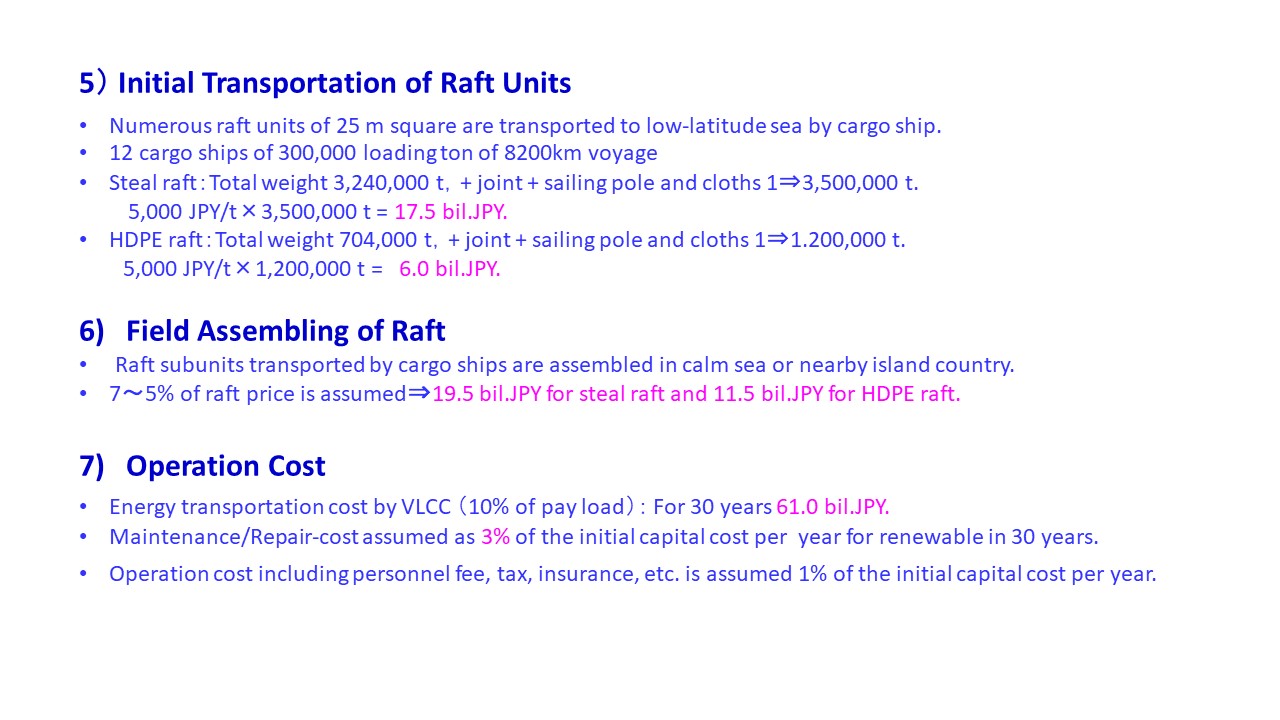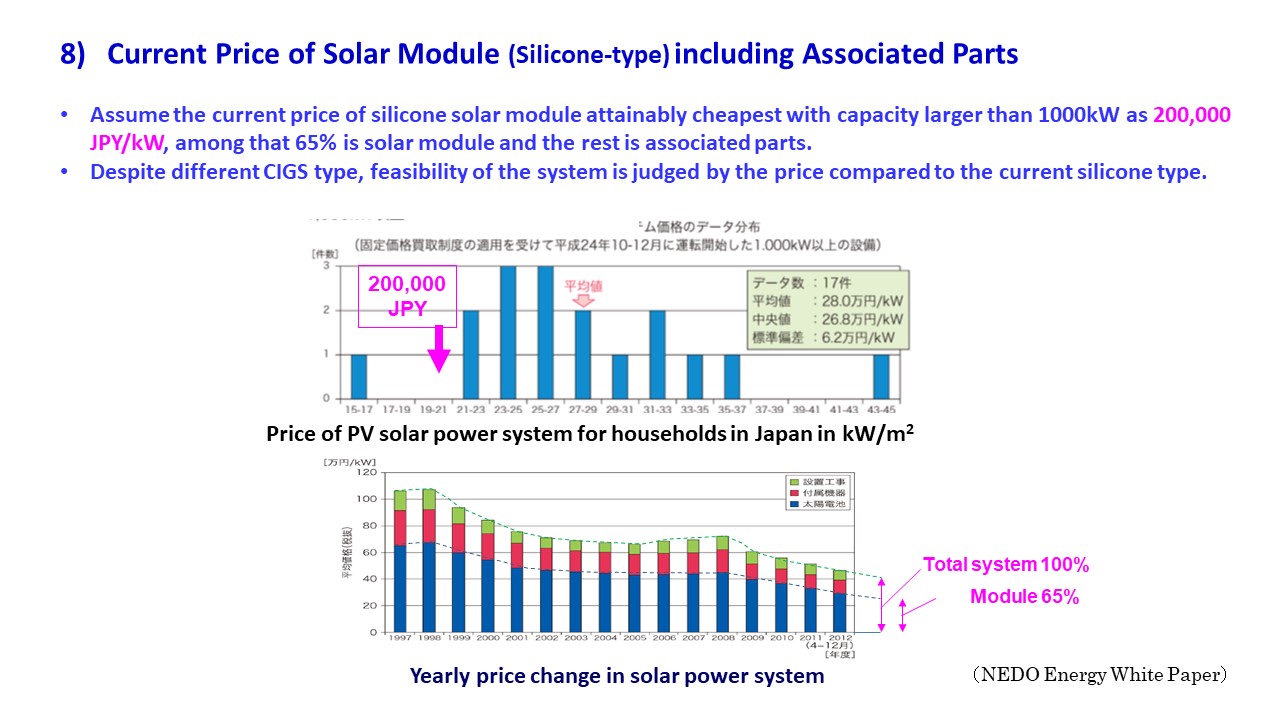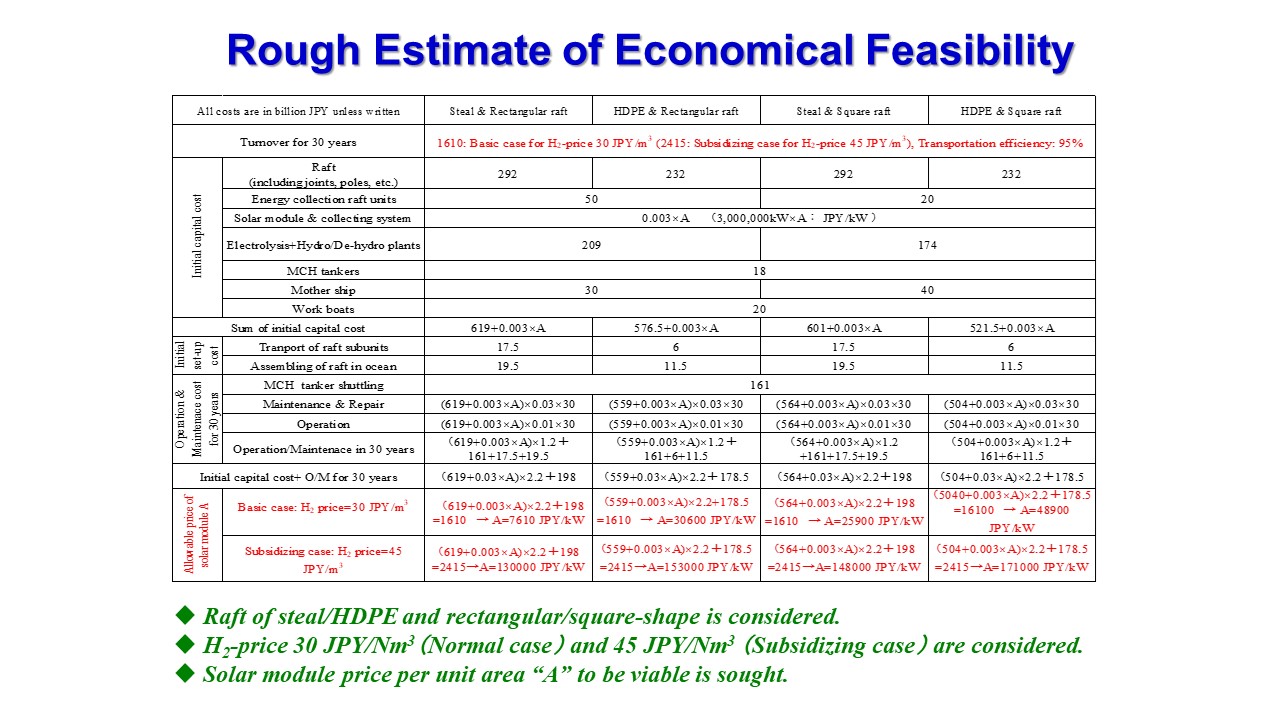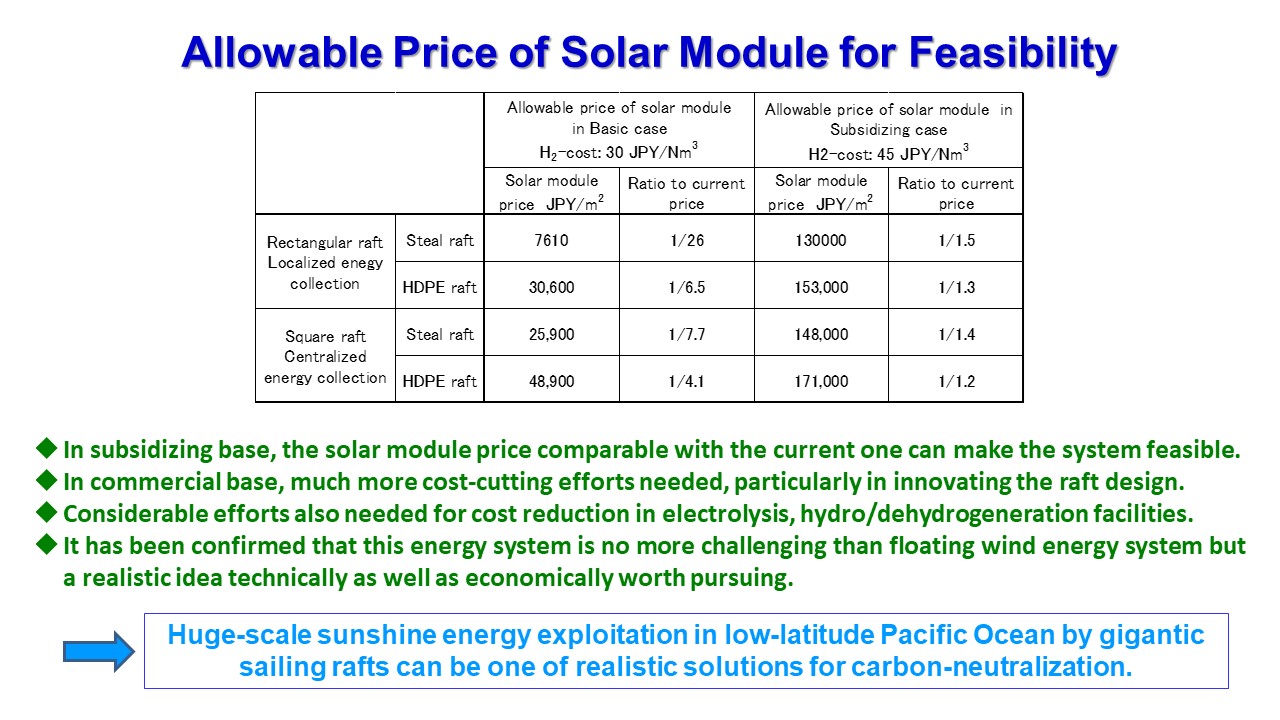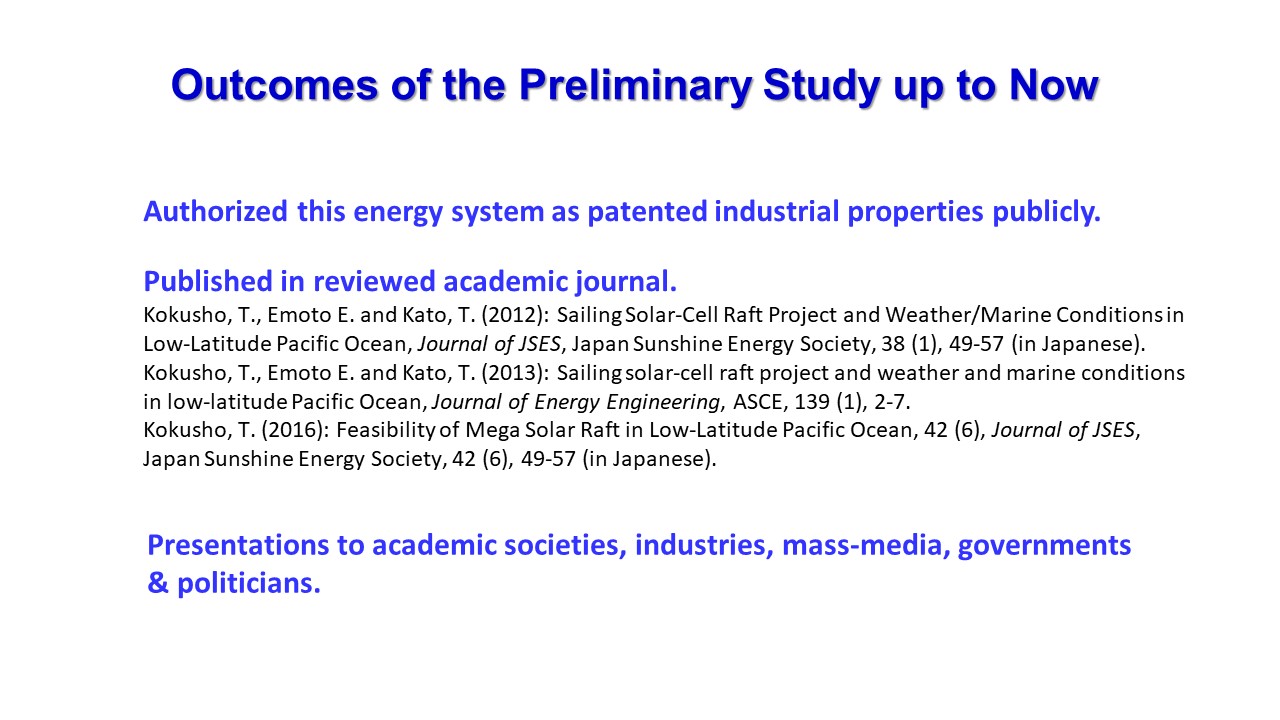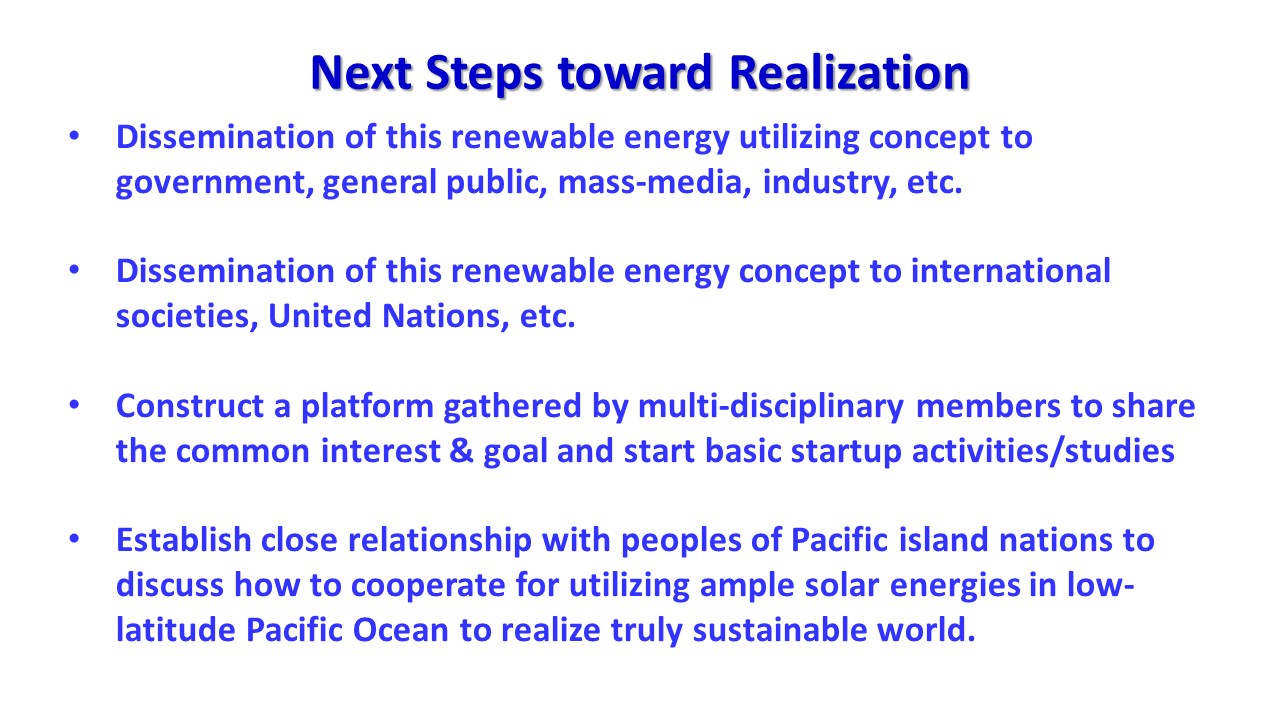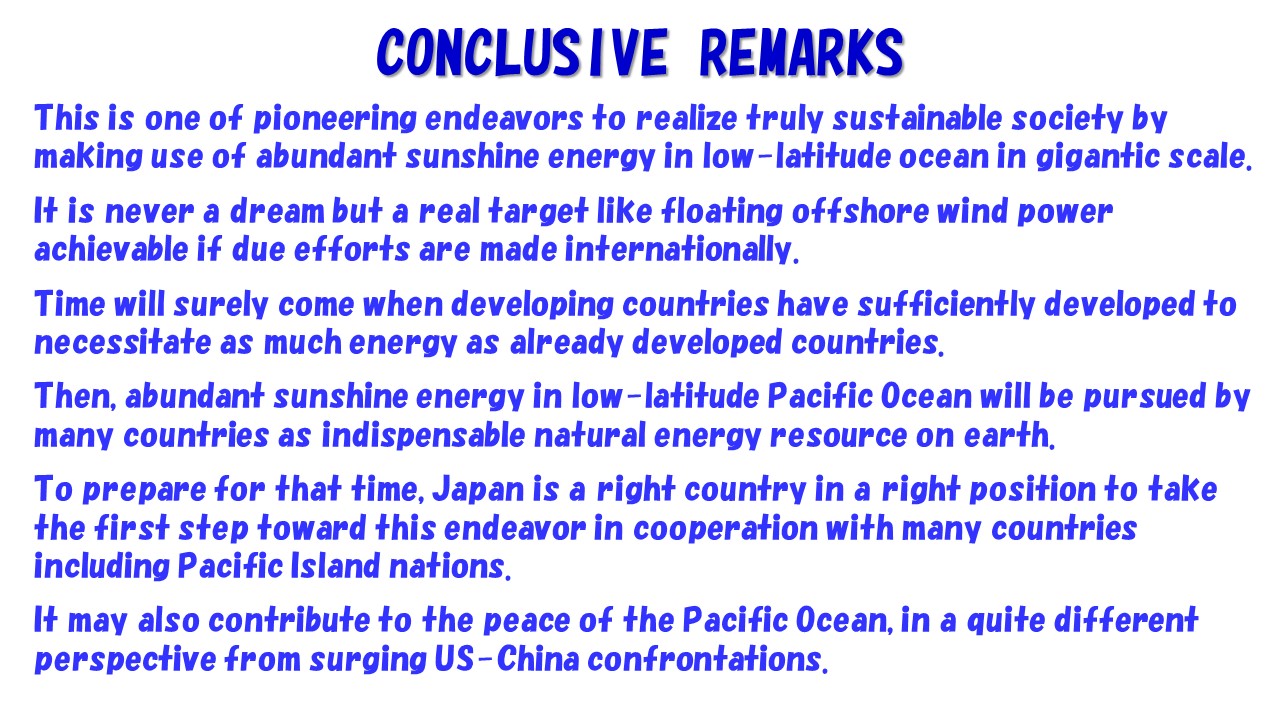Takaji KOKUSHO
Professor Emeritus, Chuo University Tokyo, Japan
Sailing Mega Solar-Module Raft Project in Low-Latitude Pacific Ocean & and Its Possibility
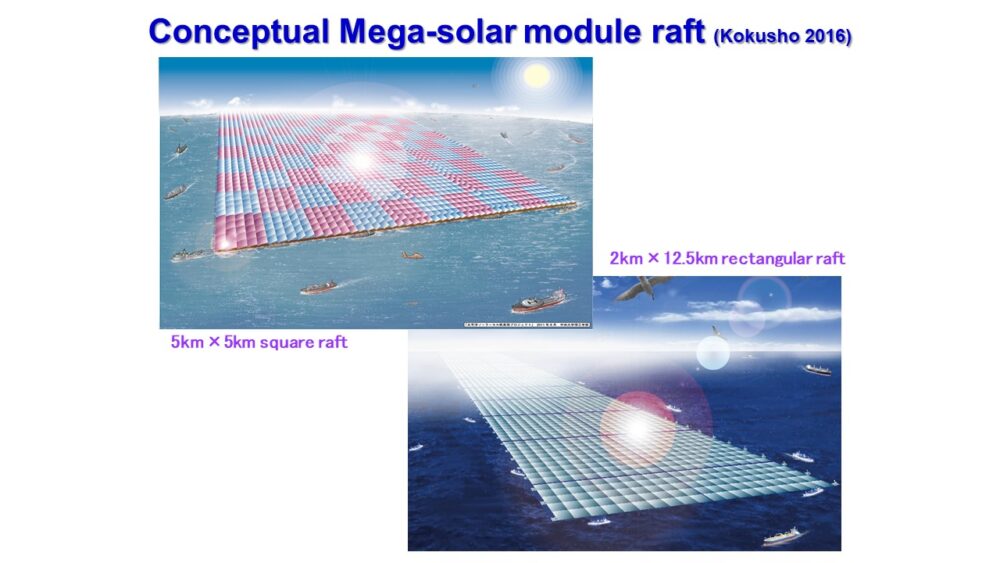
Highlight:
Gigantic solar PV raft always sailing low-latitude Pacific Ocean.
There, rich sunshine, mild winds/waves, and little typhoon risk.
Electricity transported by myriad EV batteries or H2-gas.
Solar PV modules, thin flexible type, integrated with solar cloths.
A 25km2 raft, consisting of 40000 subunits of 25m square jointed.
Estimated economically feasible if H2-gas price is 50% up.
Further innovation in design concepts realize 0.25 USD H2/m3.
Huge rafts should be accepted internationally to sail in ocean.
Outline:
The Japanese Government recently declared to fulfil carbon-neutralization of the country by 2050. However, a realistic scenario toward that goal has not yet been visualized. With its limited land areas inhabited by more than a hundred million people, it is absolutely impossible for Japan to realize this target only by land-based natural energies such as hydraulic, geothermal, solar and wind, even with the aid of operations of preexisting nuclear power stations.
The most plausible strategy the government is going to take for that goal seems to be offshore wind power similar to many other nations in the world. A number of off-shore wind power farms have already been developed in northern European countries like Denmark, UK and Germany in these decades. They are all fixed-bottom types with their foundations constructed directly on sea-floor, wherein water depth cannot be greater than 50 m at the deepest because of technology and economy. Unfortunately, most coastal seas around the Japan islands tend to increase water depth in short distance from the shore, restricting the potential capacity of the fixed-bottom type.
Hence, the floating type which can be sited in seas of 200 m or deeper are considered to be promising, wherein the wind turbine is fixed on the float moored and anchored to deep sea-floor. UK is proud of this offshore technology as a front-runner in R & D making the most of the experience in the North Sea oil/gas projects and planning to demonstrate the technology getting mature in a few years through a couple of test-site operations. The Japanese government appears to look forward almost exclusively to the floating type wind power as promising renewable energy because large sea areas may be able to be chosen as favorable sites.
However, the practical operation of the floating wind power has not yet been started even in European front-runner countries. In Asian countries like Japan and Taiwan where natural environments are more hostile with severe typhoon, high seismicity and tsunami, considerable technical problems will have to be solved before the power system can be dependable as a major player. A couple of test sites have already been decided and experimental floating wind power projects are tested for years in Japan, though their clear technical perspective has not yet been recognized publicly. Furthermore, fishing industries in Japan have historically had strong voices in using oceans all along the coasts, that may impose another constraint on the off-shore wind power.
Thus, it seems too optimistic to believe that we can depend exclusively on off-shore wind power to supply huge volume of renewable energy demand in Japan to realize the carbon-neutral. Instead, possibilities of other renewable energies conceivable in our particular conditions in the east Asian region also have to be explored.
In this respect, our research group have been proposing an innovative project for more than a decade (before the Fukushima nuclear disaster in 2011) that could be another possibility of huge renewable energy particularly in Japan; PV solar power in the Pacific Ocean, wherein huge sunshine energy affluent in low-latitude Pacific Ocean may be captured with reasonable economy by slow-sailing mega-solar module rafts if we can meet associated technical requirements.
It is no doubt the right of any countries authenticated by the International Maritime Law to make a sail in international open seas for commercial purposes, wherein renewable sunshine energy is exploited on purpose. Hence, it is considered possible to share a consensus in international forums such as IMO (International Maritime Agency) how to realize such innovative sailing for solar power generation in open seas by minimizing the impact on other sea-businesses there. Fortunately, the low-latitude Pacific Ocean are remote from major commercial sea traffics in the high latitudes.
If a giant mega-solar raft as 5 km square is considered for example, the electric energy generated only during daylight hours can be equivalent to 1 GW nuclear power stations of availability 100%, by assuming daily sunshine energy per area 8 kWh/m2, the energy conversion rate 12 % (of silicone solar module commercially available today). In the most part of low-latitude Pacific Ocean, the annual average of daily sunshine energy exceeds 6.0 kWh/m2 among that the highest can reach 6.5~7.0 kWh/m2 between the equator and 15° south in a sea expanding as vast as the Australian continent. Hence, it seems possible for the sailable raft to pursue seasonal optimal sunshine attaining 8.0 kWh/m2 (more than twice the average in the Japan island) by making an energy-saving slow-speed wind sailing.
As for the wind condition there, it is found to be very mild and stable with annually averaged wind speed of 3~7 m/s distinctly lower than in high-latitude oceans. The waves are not rough, 1~2 m high on yearly-average in low-latitude Pacific, unlike middle/high latitude throughout the year, though the solar module raft will be designed operational in much higher waves.
As the greatest risk to this mega-solar raft system, tropical depressions or storms, typhoon or hurricane, cannot be ignored. However, it should be emphasized that there are two wide sea areas literally free from the risk in the low-latitude Pacific. One is overlapping with the area of the highest sunshine energy mentioned above (due to exceptionally low temperature of sea current originated from Antarctica. Another is ±5° along the equator where tropical depressions cannot be born theoretically because of the Colioris Effect. In other areas, the risk tends to increase, though not so severe as in the middle-latitude, necessitating in-advance evacuations. It may well be expected that rapidly advancing meteorological knowledge/technology will enable reliable predictions of tropical depressions in a month ahead in near future. As for one more natural disaster, tsunami, the effect may not be critical to this energy system as long as it stays remotely from shallow coastal areas.
In our scenario to realize this system contributing to the carbon-neutral initiative by 2050, three major technologies have to become practically mature in 30 years as follows;
- The huge electric energy generated by the mega-solar module is transformed into hydrogen gas by alkaline water electrolysis and shuttled periodically either as MCH (Methylcyclohexane) or as liquefied H2-gas by huge vessels. Another possibility is to transport the electric energy directly by packages of myriad high energy-density EV batteries without energy conversion process.
- Thin and flexible solar modules (such as CIS-types or organic dye-sensitized types) seem to be promising for this project rather than conventional silicone types, thin (2 micron) with conversion efficiency of more than 12% and should be integrated with flexible sail clothes. The associated energy collection system from myriad modules all over the gigantic raft should be as simplified, cost-effective and durable as possible.
- The giant raft consisting of typically 2500 units of 100 m square, each of them further comprising 16 subunits of 25 m square on which 4 solar modules are set. All of them are connected by universal joints so as to deflect freely following wave motions. The gigantic raft is designed to be able to sail as a whole basically by wind and sea-current.
Though the hurdles to realize these widely diverged technologies seem to be too high to overcome, their technical bases are already present actually. What is needed in the next 30 years is to integrate the individual technical elements by scaling up the capacity, raising the efficiency for better performance and minimizing the cost.
In comparison with the floating wind power, this sailing solar power may look far unrealistic and more challenging. However, to construct thousands of 10~20 MW floating windfarms of 200~300 m high above sea-level in a few decades to supply enough renewable energy in Japan is also very challenging though this challenge has already been initiated by European countries and followed worldwide, while the sailing solar power concept has never been proposed before. One essential condition to realize this concept is to form an international consensus in UN or IMO accepting the sailing of huge rafts in low-latitude Pacific Ocean with due regulations for minimizing the effect on other sea-traffics.
The economic feasibility has already been estimated on the 25 km2 mega-solar raft by roughly extrapolating current state of technologies. It indicates that subsidizing the price of hydrogen by 50% will make it well viable. However, more cost-cutting efforts are further required to be commercially feasible for market-competitive hydrogen price. It is particularly needed for the giant raft to employ truly innovative design concepts for drastic cost reduction free from conventional float design concept. Essential chemical plants needed for the hydrogen transportation, if the battery transportation is not chosen, are also very costly and have to be drastically economized by incorporating advanced technology, scaling-up and mass production effects.
Though further steps are still needed to reach to the gigantic 1 GW system, it seems possible to realize a smaller capacity mega-solar module raft to practically operate in low-latitude Pacific by 2050 because the basic technologies are already in our hands. Also note that such an innovative green energy initiative where international multidisciplinary cooperation is critical will surely lead to creation of next-generation disciplines in science & technology, new markets in business and job opportunities not only in Japan but all over the world. That will make an epoch bringing all human beings on earth to a new horizon to live a truly sustainable life without burning fossil fuels.
One may wonder if such a green-energy initiative in the low-latitude Pacific Ocean may be able to coexist with the current circumstances of US-China power struggle conducted right there. Because of that, however, it is really meaningful from a quite different perspective of world peace to start this initiative in cooperation firstly with Pacific Island countries as well as with many other interested nations.
Time will surely come sooner or later when developing countries have sufficiently developed and demand as much energy as pre-developed countries. Then, abundant sunshine energy in low-latitude Pacific Ocean will be targeted by many countries as indispensable natural energy resource on earth. To prepare for that time, Japan is a right country in a right position to take the first step to this endeavor in cooperation with many other countries including Pacific Island nations.
Thus, besides offshore wind power, we may possibly be able to have another option of huge renewable energy. Why do not we expand our sight and investigate the possibility to make use of abundant sunshine energy in the Pacific Ocean that nobody has ever tried.
References: Kokusho, T., Emoto E. and Kato, T. (2012): Sailing Solar-Cell Raft Project and Weather/Marine Conditions in Low-Latitude Pacific Ocean, Journal of JSES, Japan Sunshine Energy Society, 38 (1), 49-57 (in Japanese). Kokusho, T., Emoto E. and Kato, T. (2013): Sailing solar-cell raft project and weather and marine conditions in low-latitude Pacific Ocean, Journal of Energy Engineering, ASCE, 139 (1), 2-7. Kokusho, T. (2016): Feasibility of Mega Solar Raft in Low-Latitude Pacific Ocean, 42 (6), Journal of JSES, Japan Sunshine Energy Society, 42 (6), 49-57 (in Japanese).
The following is a PPT presentation material associated with a lecture delivered in Energy Committee of Japan Society for Civil Engineers in January 2020, where a more detailed information on this energy project is available as translated into English.
